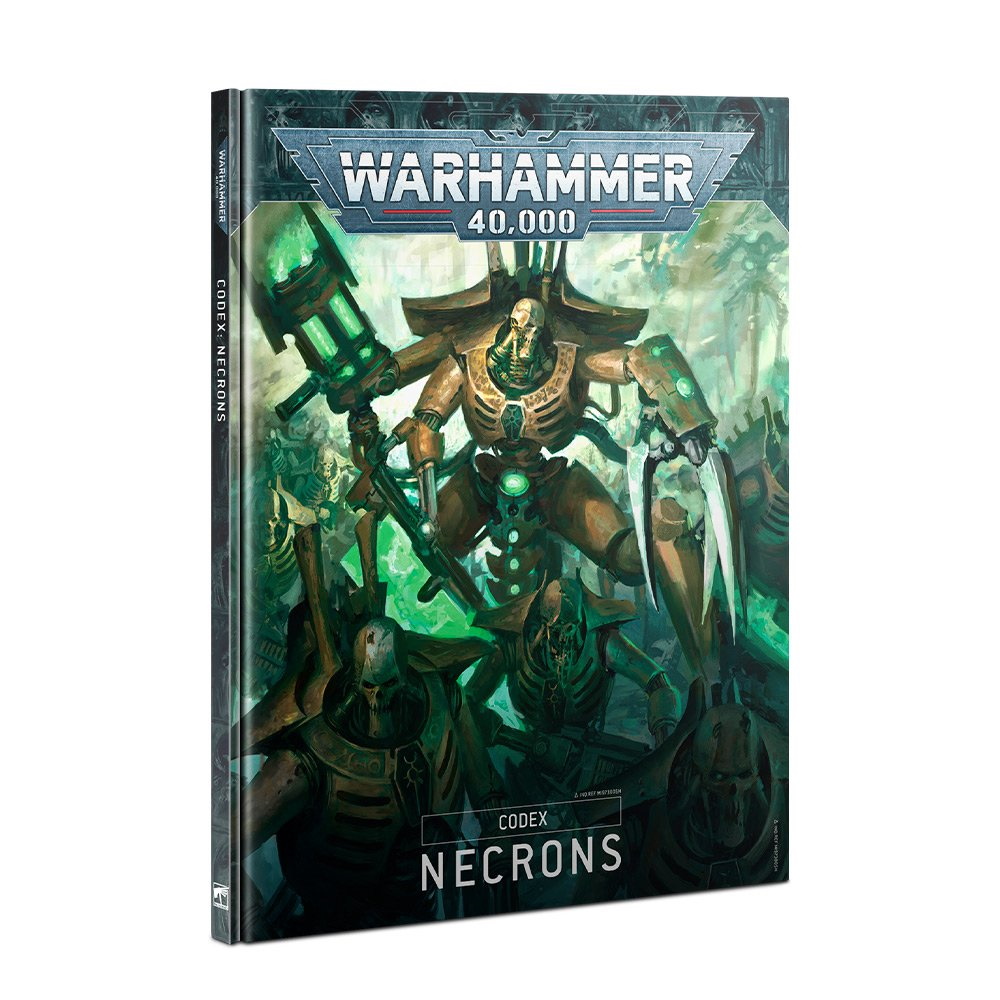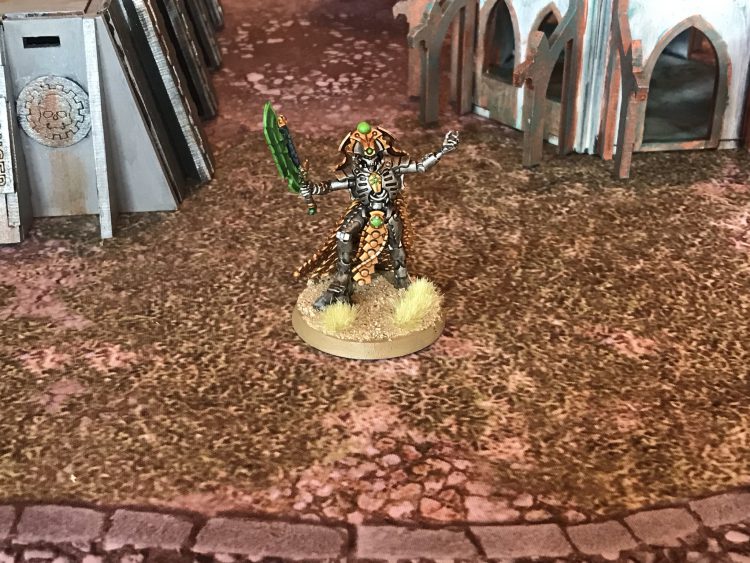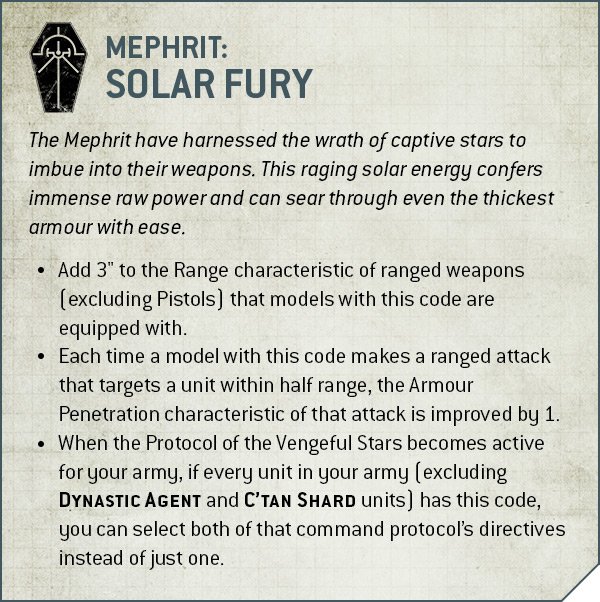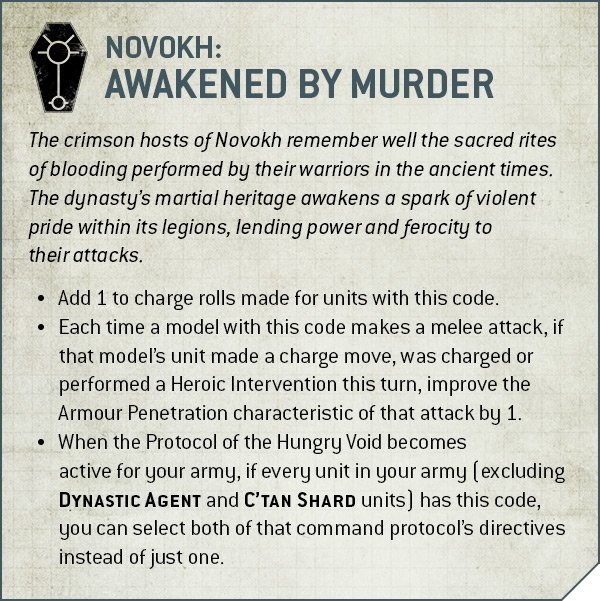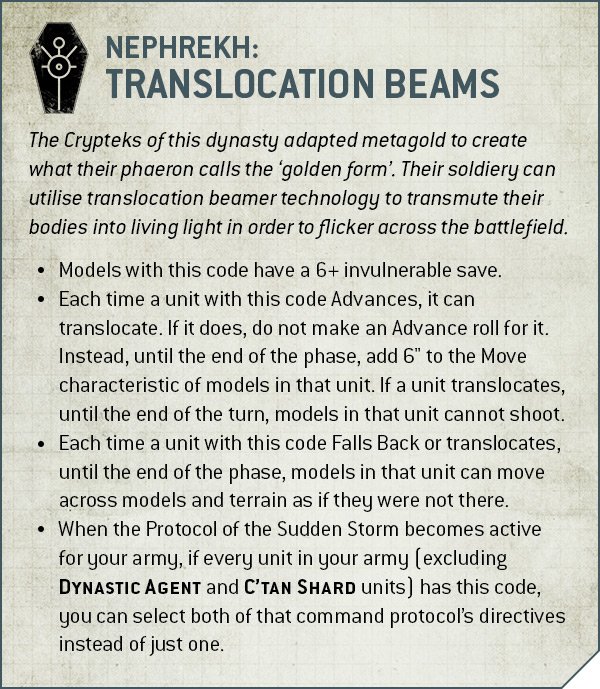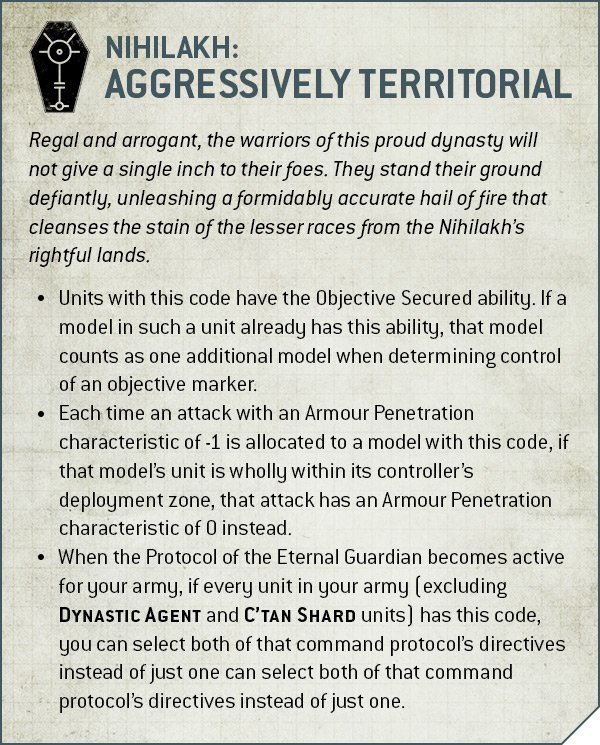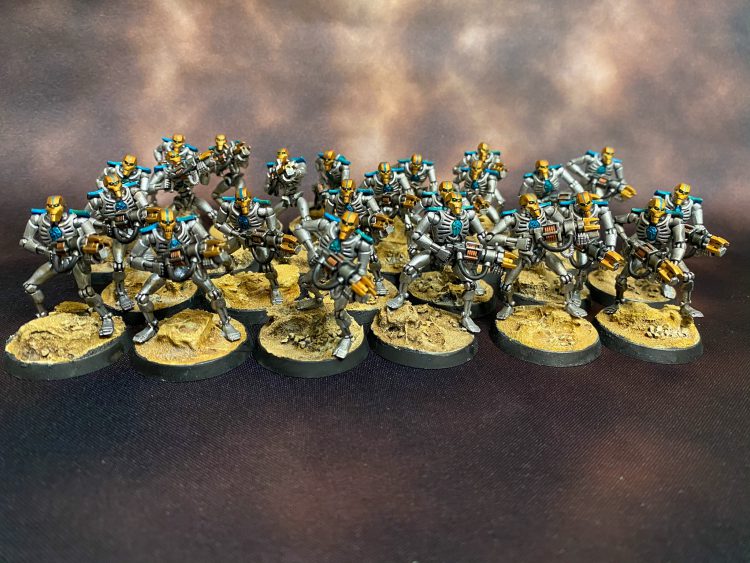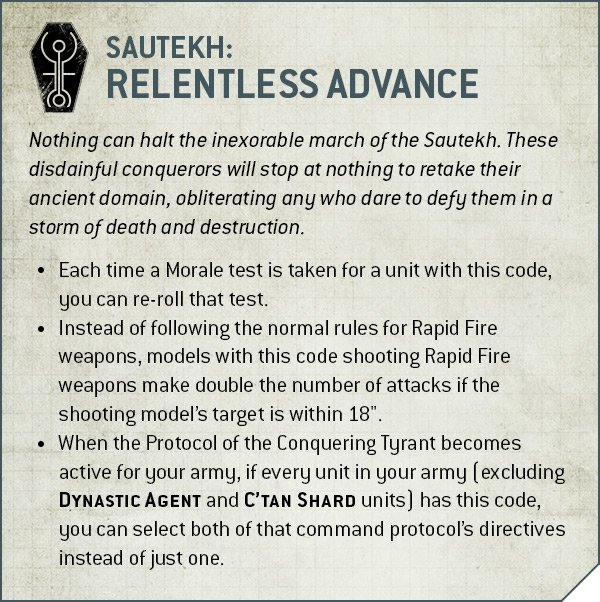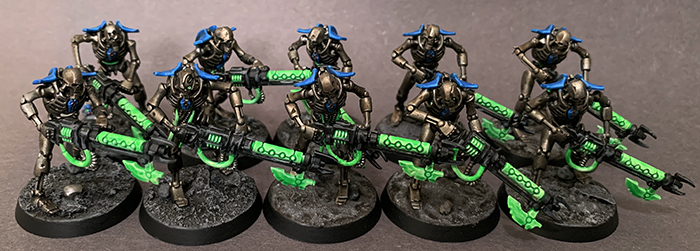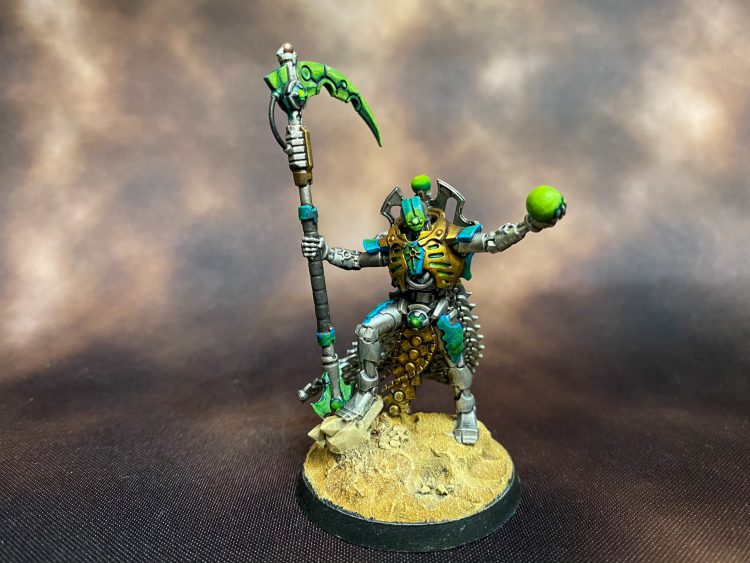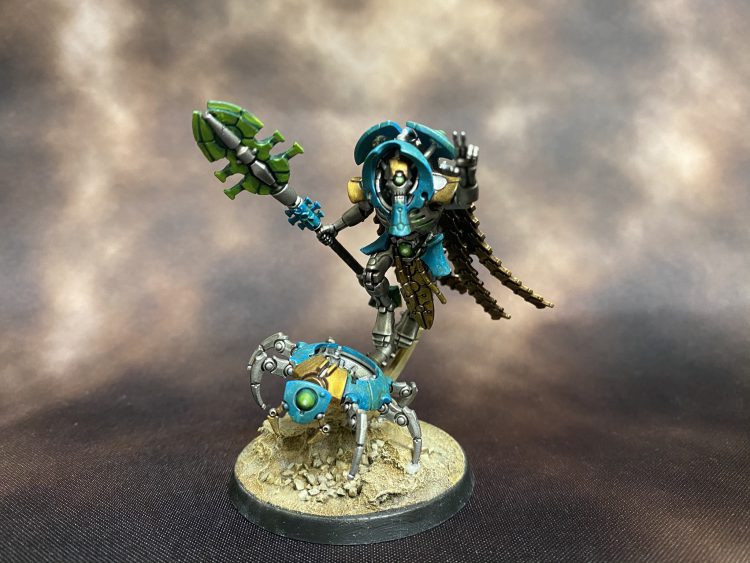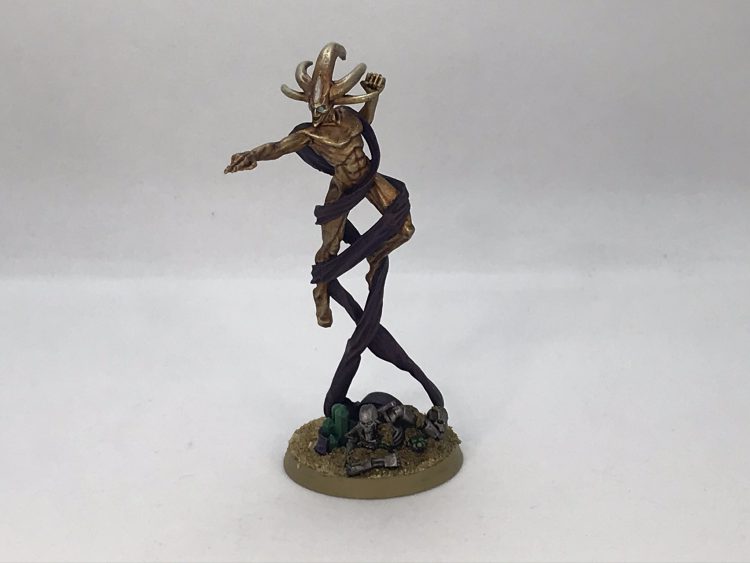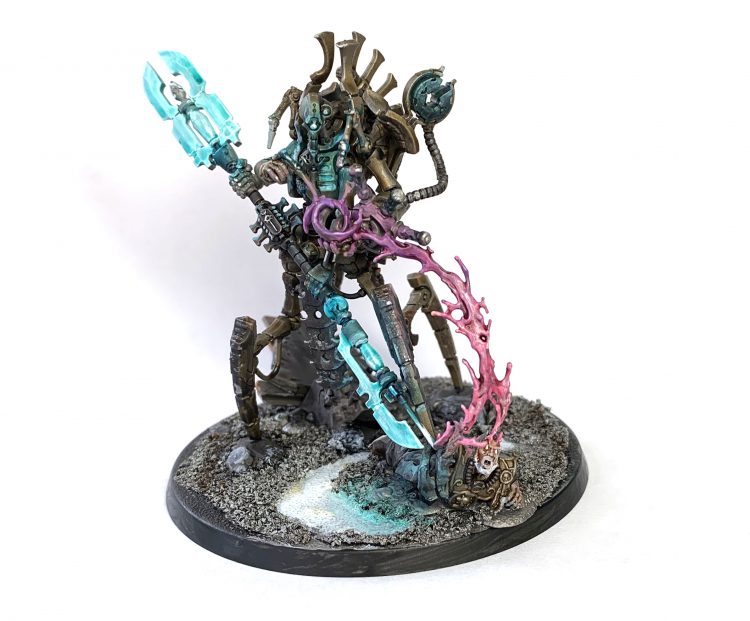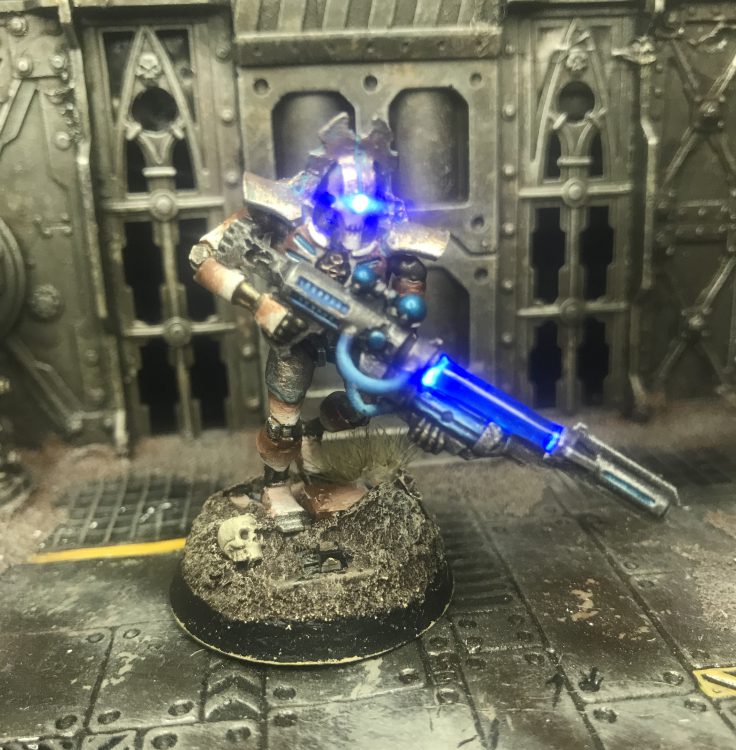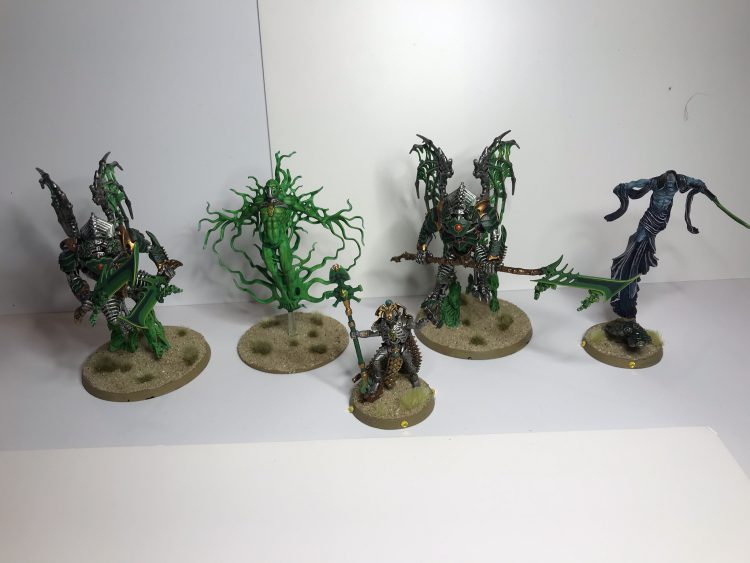Cover Image Credit: Games Workshop
We could do a sensible introduction to this. We really could. Perhaps should even. Nevertheless…
HERE WE GO MORTALS!
OVERLORD WINGS IS BACK!
After suffering through the whole of 8th with an extremely underpowered Codex, Necrons are at the front of the queue for 9th Edition, and in the opinion of your humble ARROGANT AND GLORIOUS correspondant it’s good news. The new book represents a near ground-up redesign of the faction, both unlocking a huge array of new choices and giving us a hint of the direction that Games Workshop want to take 9th Edition. A whole host of exciting new options awaits budding Phaerons, while a whole bunch of existing units get gigantic shots in the arm, and the net result is that the faction feels incredibly exciting for the first time in…well ages.
Today, we’re going to try and give you an overview of the key details from this book – and there’s a lot. We’re going to do our absolute best to cover everything today, but it’s clear that the degree of upheaval that 9th Edition Codexes are going to represent is significantly greater than any changes we saw in 8th. If this review leaves you wanting more then stay tuned over the next week or so, as we’ll have plenty more follow up coverage from our regular columns, as well as deep dives into some specific list options. Without further ado, let’s get on with the show – it’s going to be a big one.
Table of Contents
Why Play Necrons?
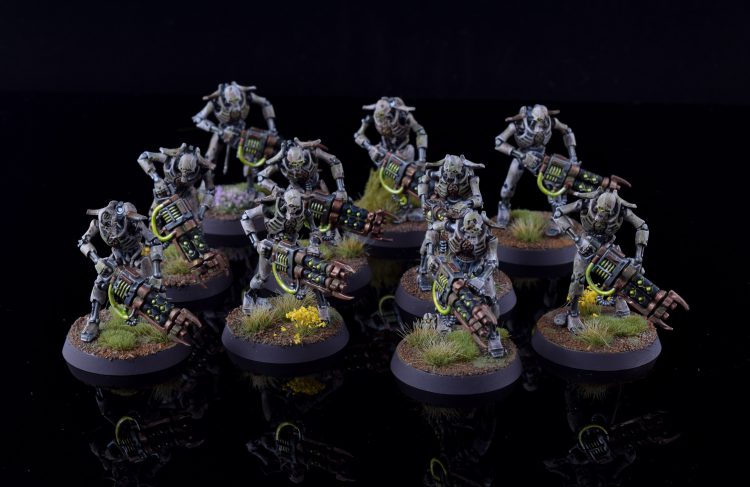
With a whole new Edition, and Necrons featuring in the starter boxes, there are likely a lot of new players wondering if Necrons might be for them – so why should you play Necrons?
With the new book in play, Necrons play pretty much how you’d expect just from looking at them. Legions of durable infantry lumber up the board, surrounded by a panoply of strange and terrible damage dealers, whether they be viciously be-clawed constructs, robot space wizards wielding arcane relics, imprisoned star gods or looming ancient war machines. Your core forces are extremely durable, while your specialist units are exceedingly effective when deployed in the right situations. The tradeoff for all of this is that you have to think ahead. Many units are relatively ponderous, while the powerful Command Protocols have to be planned out before battle is even joined. Get your strategy right and you can grind your foes before you. Get it wrong, and the pesty galactic usurpers will run rings around you, forcing you to make a tactical withdrawl to your tomb world rather than be undone.
Necrons feel like they’re going to reward players who really get to know their army. There’s enough raw power and toughness here to be forgiving in early games, but a deep understanding of how best to use your forces is going to be needed to get the most out of them. The faction also has a lot of support for themed armies – powerful options are available that will reward going deep on either Canoptek constructs or Destroyer Cult units. This is also great news for existing Necron players – pretty much whatever set of tools you have access to, there will be a way to put them together that leverages the new book. The update is especially exciting if you favoured Warrior or Canoptek-based lists, both of which look vastly more interesting compared to 8th, where Immortals, Destroyers and vehicles were the main game in town – and on that note, let’s look at what the book covers.
What’s in the Book?
This book is massive. and absolutely packed with rules. It’s also just an extremely nice tome – just like the 9th Core rulebook, the amount of effort that’s been put into layouts and design really shows, and this feels like a much better product than its equivalent in the previous edition. That’s true whether you like pretty books or exciting rules – while the total page count of the 8th and 9th Edition Codexes is the same, there are 30 more pages that have rules content on them this time around. What makes that up? Well the book contains:
- Detachment abilities for 6 named Dynasties plus custom ones.
- 34 generic stratagems and one for each named Dynasty.
- Warlord Traits and Relics to upgrade your characters.
- Cryptek Arcana, purchaseable space wizard upgrades.
- A souped-up list of C’tan powers, including unique ones for the three named shards.
- 8 pages of Crusade rules, giving access to flavourful rules for narrative play.
- 4 Necron secondaries for matched play games.
- Command protocols, a new set of army-wide buffs you can plan out through the turns of the game.
- 51 datasheets and accompanying rules to build your legions.
- A code to unlock all of this in the app. They’re there as promised.
We’re going to focus today on the content that’s relevant for matched play – our Crusade specialists will be bringing you their thoughts on the new rules for narrative campaigns next week.
The Five Best Things About This Book
Shortly, we’ll go deep on the host of new and improved options available to Necron players, but just in case your pressed for time, we thought we’d start off with what we think the five standout changes are. If any of these sound awesome to you, then you’re probably going to enjoy this book!
- Warriors are back! Updated reanimation protocols and various buff options make the silver tide useful again.
- Melee is good now! Being able to compete in the fight phase is proving essential in 9th, and this book gives Necrons the tools to deal with their opponents up close.
- C’tan are terrifying! C’tan get a gigantic power boost (and, to be fair, cost hikes to match) making the star gods the absolute monsters they should be. Especially the NIghtbringer. Oh we’ll get to the Nightbringer.
- Depth! There. Are. Options. If you wanted to compete with Necrons in 8th at all you basically had one core to build around. That’s no longer the case, with valid routes to horde, ranged or melee strategies.
- The Silent King! He’s, uh. Quite good. Yeah.
From here on out, we’re going to be going through the various sections of the book and looking at what they mean for players. We’re going to look at the army abilities first, mixing up the order from the book a bit, and then cover the datasheets, and look at some hot new lists at the end.
One last quick note, I guess – it’s going to be pretty clear in this review but I am unbelievably excited about this book. I started a Necron Army in 8th to provide an alternative option for events, but that never really came to fruition outside of occasional skew list outings due to how weak the 8th book was. From an initial read it feels like that’s about to change in a huge way, and I could not be more hyped. I will try and maintain my objectivity – there’s some stuff here I still think misses the mark – but this is going to be more effusive than my normal fare because my army might actually be good now.
Army Abilities
Keywords
A bunch of rules in the Necron Codex work based on a set of common keywords that turn up across multiple units. The most important ones are:
- Core: As heavily previewed, this indicates units that are meant to be the backbone of an army, and have access to the most buffs. Here, that’s Warriors, Immortals, Tomb Blades and Lychguard. It’s a surprisingly short list compared to Marines. However…
- Canoptek: There are a lot of abilities that work on Canoptek units, giving you a second category of things with access to powerful buff options.
- Destroyer Cult: …and, in fact, let’s have a third. Another category for buff effects.
- Noble: This keyword is required to activate certain abilities, and also plays into determining who your Warlord must be. It appears on the Silent King, Overlords, Lords and Catacomb Command Barges.
- Dynastic Agent: Units that can be added to any Necron detachment without breaking detachment abilities or protocols.
- C’tan Shard: Same as Dynastic Agent, and you can also only include one per detachment.
There are a few others, but they’re condensed enough that we’ll just talk about them when they matter.
The Royal Court

Representing the strict operational hierarchy of Necrons being coded into their very beings, you are now restricted in how you choose your warlord. Basically, if your army contains any NOBLES, you have to pick the most senior of them to be your Warlord. Since you will almost always have a NOBLE, this will come up most games. The hierarchy goes:
- The Silent King. He’s the boss. No arguing.
- Any Phaeron model. This means Imotekh or a stratagem-upgraded Overlord.
- Any Overlord.
- Any Lord.
If you have multiple models at the same tier you can choose between them, and if you have none of these you can pick who you like…but lose access to Command Protocols, so probably don’t do that.
Special Rules
Necrons have four special rules shared between a lot of units:
- Reanimation Protocols: A chance for models to get back up after they die, appearing on all multi-model units, even Canoptek units that missed out before.
- Command Protocols: A set of special rules that activate one-per-turn and grant your characters buff auras if certain conditions are met.
- Dimensional Translocation: A generic rule for all units that can deep strike in the reinforcement step. It’s the standard 9″ distance, and it’s nice to see it codified centrally.
- Living Metal: Wounded models with this ability regain 1W in your command phase. All multi-wound units get this, again including Canoptek units like Wraiths and also, importantly, C’tan.
- Quantum Shielding: Rewritten completely, this now functions as both a 5++ and a permanent transhuman (can only ever be wounded on 4+).
Right up front, the substantially increased breadth of Reanimation Protocols and Living Metal is great. We’ll dive into the specifics of the new version of Reanimation in a second, but it just being everywhere without you having to think about it now is great. Same goes for Living Metal – with lots of multi-wound options having received a big glow-up, this applying to all of them is a nice minor upside. It’s also wild on C’tan shards thanks to their Necrodermis rule preventing them from losing more than three wounds in a phase. That’s all that really needs to be said about that, and Dimensional Translocation is just a consolidation of a bunch of effects that would otherwise have been printed on lots of sheets, so again we don’t need to go deep on it. Let’s look at the two big hitters from this section.
Reanimation Protocols
Reanimation has been the signature move of Necrons for most of their existence, but in 8th it was bluntly terrible. It gave a chance for dead models from your units to get back up at the start of your turn, which was cool in theory but in practice ran face-first into the lethality of 8th. Even with 20 Warrior blobs, I can tell you from repeat personal experience that competent opponents would just burst them down in a single turn, deleting them without you ever getting a chance to trigger this. Given that most units with the ability had a point premium that assumed it would sometimes do something, this hurt like hell.
This has been completely replaced, as previewed on Warhammer Community:
That’s a lot of words. Here’s a shorter version involving props:
- When an enemy unit shoots or fights, if any of your models are destroyed, put a number of reanimation tokens in a pot equal to the total starting wounds of the destroyed models (so if four Lychguard with two starting wounds each die, put eight tokens in the pot).
- If your unit survives, after the enemy unit finishes all their attacks, roll a d6 for each token in the pot. Keep any tokens where you rolled a 5+, and discard the rest. With our Lychguard, lets say we roll 3 5+s, so we keep three tokens.
- You can use the tokens left to buy back whole models. Models cost a number of tokens equal to their starting wounds. With our three tokens, we can buy one whole Lychguard, with one token left over.
- Discard any tokens that can’t buy whole models. In our example, we discard our one remaining token.
So what does this mean? Well, the important takewaways are:
- This is a lot better for single wound models, and outperforms an ignore wound effect like Disgustingly Resilient. It doesn’t matter how hard your model gets hit – they still get back up straight away on a 5+.
- The more wounds you have, the worse this gets. Because you have to get enough successes to buy a whole model from a single set of attacks, if your opponent gradually grinds down multi-wound units this won’t do very much. In the old days occasionally getting a bunch of free Destroyers was the main draw of this, not so any more.
- There are some abilities that mess with this in a positive way – most notably the resurrection orb. However, there are fewer “easy” modifiers to it than before.
The last point is worth exploring. Up front, the bad news is that the old Cryptek +1 to reanimation aura is gone. It’s a shame for Necron players because it would have been very good with this new rule, but honestly probably a bit much given the power in the book. Technomancers, one of the Cryptek sub-classes, can now reanimate a single dead NECRON CORE model from a unit (or d3 Warriors) in your command phase in homage to their old abilities, but don’t expect to be routinely rolling this on a 4+. The only sources of that are Canoptek Reanimators, which still have a terrible statline and the Orb of Eternity relic. You do have one more angle to mess with the rolls directly in the Protocol of the Undying Legions, where one directive lets you re-roll one dice each time this triggers, but by and large you’ll be rolling this down the line, and once you’re done your models are gone. Or are they?
That’s where the Resurrection Orb comes in, infused with vastly more purpose than it had before. Ironically, it still basically does the same thing – once per game in your command phase you pick a unit within 6″ and roll reanimation for all dead models in the unit. However, this is obviously now much more important, as it’s a way for you to bring back models that failed to reanimate the first time around, and punishing your opponent for trying and failing to achieve a full kill on one of your units. There’s now a real appeal to trying to squeeze one of these into your armies, as it lets you have your cake and eat it – you get access to the new, improved ongoing durability while still getting to utterly dunk anyone who comes at you and misses.
Overall, I am pleased about this change. While it hurts some units, most notably the large Destroyer squads that were staples of older builds, I’m reasonably convinced that the payoff in making the core 1W infantry much, much better is worth it, and it being rolled out for free to a bunch of Canoptek stuff is just gravy.
Command Protocols
Done with the old, now for the new. Command Protocols are a new ability that grants changing bonuses to your army over the course of the game, as long as you’ve kept your command structure in place. The ability appears on the datasheet of all units except the C’tan shards and the Tesseract Vault, but just having the ability doesn’t unlock the effects by itself.
Activating Command Protocols
In order to use Command Protocols the following has to be true:
- Every unit in your army that isn’t a C’tan Shard or a Dynastic Agent has to be from the same Dynasty. That means mixed-dynasty lists switch these off, likely making them quite rare. The good news is that although the Silent King is from the Szarekhan Dynasty, he’s a Dynastic Agent as well, so you can include him alongside an army using another Dynasty and still benefit from these.
- Your warlord has to be a NOBLE. I personally plan to take Catacomb Command Barges a lot.
As long as you meet the first two conditions, then before the game you prepare command protocols. There is a list of six of these, each with two effects, and after deployment but before the first turn roll-off you choose five of these and assign one to each of the five battle rounds of the game.
At the start of each battle round, one final condition is checked:
- At least one NOBLE is on the battlefield
If you meet that, you reveal the protocol chosen for that round and choose one of the two effects. Any unit with the Command Protocols ability then benefis from that effect while it is within 6″ of a Necron CHARACTER.
The Protocols
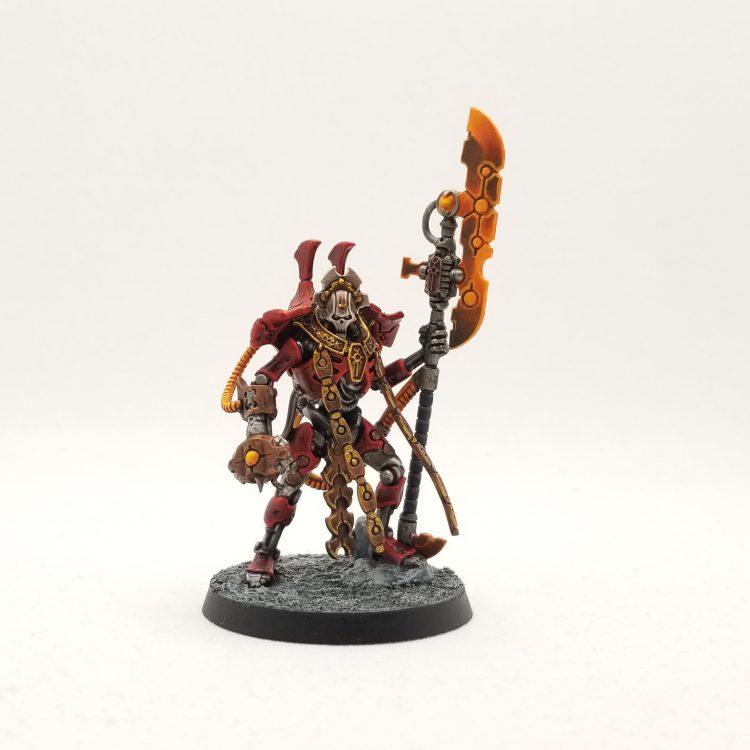
Sounds promising, and it is – this is pure upside. For it to be great, however, the effects need to be good, so let’s take a look.
As mentioned before, each of these has two effects and you can only pick one – unless your detachment is from a Dynasty that favours that specific protocol, in which case you get both when that one activates.
- Protocol of the Eternal Guardian: EIther be in Light Cover in the open if you haven’t made a Normal Move, Advance or Fall Back in this battle round, OR effectively count as being in defensible terrain. Notably, because the move check is on a battle round basis, the first effect will almost always be “on” if you went second in the game, whenever you chose to activate it. Favoured by the Nihilakh dynasty
- Protocol of the Sudden Storm: +1″ move OR shoot while performing Actions without failing. Favoured by Nephrekh.
- Protocol of the Vengeful Stars: Additional -1AP on 6s to wound when shooting OR ignore Light Cover within half range. Favoured by Mephrit, surprising no one who’s familiar with them.
- Protocol of the Hungry Void: Additional -1AP on 6s to wound when fighting OR +1S in the first round of combat. Favoured by Novokh.
- Protocol of the Undying Legions: Gain 1 extra wound from Living Metal OR re-roll 1 dice each time reanimation activates. Favoured by the Szarekhan.
- Protocol of the Conquering Tyrant: Add 3″ to aura abilities and a selection of targeted buffs OR fall back and shoot at -1. Favoured by the Sautekh.
Impact
This is a very cool ability. While some of the effects are clearly better than others, there’s use cases for all of them, and while the boosts are mostly incremental they will add up over the course of the game. I also like that having two options for each protocol tends to mean that most builds will find a way of using all of them
Strategically, working out how to get the most out of these is a real challenge. The Szarekhan have access to a few effects that let them mess with the operation, but there aren’t any generic stratagems or effects letting you reorder or repeat these once you’ve picked your order, so getting the choice right up front is going to be a test of skill.
The ones that most catch my eye are:
- Light Cover from Eternal Guardian. This one’s super interesting, because there’s a huge tension inherant in it. If you’re worried about getting alpha striked you might choose to line it up for the first turn – but then if you end up going first it probably does nothing for many of your units. I do also find it amusing that performing a charge doesn’t switch this off.
- Both halves of Sudden Storm. The 1″ move stacks nicely with Relentless March to get you out of the gate quickly early on, while the ability to shoot while Actioning is novel and cool. Another one you might want right at the start, but again there’s a healthy strategic tension between doing that or saving it for Action purposes later on.
- +1S from Hungry Void. This is substantially above the curve compared to all the other offensive buffs here, and if you time it right this can be horrific.
- RP re-rolls from Protocol of the Undying Legions. Helps a lot to tilt the probability of this actually working on multi-wound units, particularly 2W models.
Those are the ones I’ll be looking at with most interest as I try and figure out how to really optimise this effect.
The existence of this ability also impacts on army design. You want:
- A NOBLE warlord pretty much every time.
- Confidence that you can keep a NOBLE alive, either by picking a tough warlord or bringing a spare. Catacomb Command Barges feel very good for this.
- Enough CHARACTERs dotted around to spread the effect. Here, being able to take two Crypteks in a single HQ slot helps, as does the option of the Hexmark Destroyer, a cheap non-HQ character who can drop in wherever needed.
I’ve definitely already noticed this impacting my list-building choices, and it’ll also have a big impact on positioning during games, as there’s going to be a real trade-off in some turns between staying in range for protocols or going out hunting.
Overall, huge fan – it’s flavourful, interesting, powerful and generates a lot of depth and meaningful decisions. Top marks.
Dynastic Codes
Just like most armies, Necrons have sub-factions each specialising in different aspects of warfare, in this case the Dynasties. Most units have a <DYNASTY> keyword, which you replace with the name of one of your choice when adding them to your army. Choosing to draw a whole detachment from the same Dynasty allows units in that detachment (other than Dynastic Agents and C’tan Shards) to benefit from a Dynastic Code, boosting their capabilities.
The codex contains six named Dynasties, each of which offer you a two-part Dynastic Code plus a bonus to one of the Protocols. Each named Dynasty also gets a unique stratagem, relic and warlord trait. In addition, for the first time for Necrons this book introduces custom Dynasties, allowing you to pick one effect from each of two lists to make up your faction traits. These have varied wildly in power between books, and the good news is that here they’re at the strong end. A lot of the same effects that appear on the named codes turn up in these lists, allowing you to build a main effect of comparable or maybe even greater power. You do lose out on the additional bonuses, but there are a couple of unique and very potent effects on the custom trait list that genuinely feel like they might be worth experimenting with.
Mephrit
The Mephrit love to shoot stuff, gaining +3″ range to all their guns, and getting +1AP to their shooting within half range. Confusingly, their warlord trait is somewhat at odds with this, giving +1S and +1A, but their relic and stratagem are more in order, being a boosted relic gauss blaster and a ability to tack some mortal wounds onto a volley of shooting respectively.
Necrons have quite a lot of ways to put out large volumes of medium strength firepower that struggles with AP, so finding ways to stack up lots of Tesla or enmitic weaponry is the best way to get value out of this. Tesla in general takes a bit of a knock in this book compared to 8th, but if there’s a place for using lots of it Mephrit is going to be it. Tomb Blades and Annihilation Barges really come into their own, while using large numbers of gauss flayer equipped warriors to leverage the various strats that boost rapid fire weapons also feels like a potential option. Equally, it’s possible that making the gauss reaper 15″ range is just what’s needed to make it more flexible on the battlefield.
Novokh
At the other end of the scale, Novokh favour brutal melee combat, giving their units +1 to charges and improving their AP by 1 in the first round of combat. Their stratagem further hammers this home, giving a unit +1A for a turn for 1CP (an exceptionally good rate), and while their warlord trait and relic are a bit underwhelming, the overall package here is very powerful.
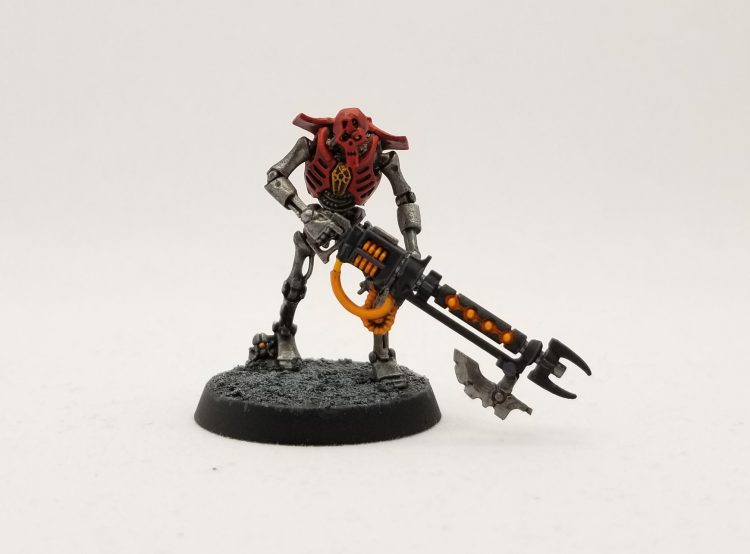
Across the board, this book provides a lot of good options for a melee strategy, and Novokh supports that exceptionally well, giving it a good chance of being one of the strongest dynasties. Taking the trait and stratagem together, pretty much any unit in a Novokh army becomes capable of doing some damage in the fight phase, and the units that were already good at it become exceptional. The AP improvement is also subtly good with Canoptek Scarabs – now these auto-wound on 6s to hit, boosting their AP makes a bit difference. Novokh also benefit from the Protocol of the Hungry Void being one of the strongest, and working well with the Silent King. Using his Warlord trait to double up Hungry Void for turns 2 and 3 in combination with everything else here feels like it’s going to be absurdly brutal, and I would recommend not sleeping on the most vicious of the Dynasties.
Szarekhan
The Szarekhan dynasty feel like they favour ranged war machines. Their trait gives a 5+++ against MWs and one wound re-roll per round of attacks. Their stratagem is the always powerful 4+ deny – less good now you can’t re-roll the dice, but still a headache to play around. Both their warlord trait and relic mess with command protocols in powerful ways. The trait lets you pick four protocols instead of five, and choose to double up one of them for two rounds. Meanwhile, their relic (for a NOBLE) essentially extends command protocols to 9″ around the warlord, and lets CORE units always benefit from both halves of the active protocol. The Warlord trait feels like the better of the two things here simply because Szarekhan don’t feel like the Dynasty that wants to go heavy on CORE units, but it’s nice to have the option.
Like any per-attack re-roll effect (and for what it’s worth, only getting either the hit or wound appears to now be the standard), you get the most benefit from this when you stack up units with a few powerful shots. The extremely aggressively-costed Canoptek Doomstalkers are good for this, as are single-model Heavy Lokhust units with the gauss destructor, Plasmancers and Chronomancers. Small, powerful melee units also benefit quite a bit, and I can see this working well with minimum-sized Wraith and Skorpekh units too, Wraiths in particular enjoying the mortal wound protection. It’s also important to stress how exceptional this trait is on Szarekh himself, and getting to dip into this and the Warlord Trait even while running him alongside another Dynasty is exceptional – big LOWs love mortal protection, getting re-rolls on his preposterous doom beams is hilarious, and unlocking the deny strat for when mean elves try to Doom him is great. Note: a reader has pointed out that Szarekh may not actually get the trait here, as being a dynastic agent excludes him. He still gets the warlord trait and strat unlock, which is still good.
There are plenty of small, elite units that are priced to move now, so it feels like there are places to take the Szarekhan – but as above, expect to see some of it on the table a lot as the Silent King flexes his considerable muscles.
Nephrekh
My favourite Dynasty doesn’t disappoint – Nephrekh keep a modified version of their old translocation effect, and gain an army-wide 6++. The translocation has changed a bit – it’s now optional when you advance to activate it, and when you do it still lets you auto-advance 6″ and move through models and terrain while doing so. It does now come with the tradeoff that you cannot shoot at all after doing it, but a further upside is added in that the move-through-stuff effect also triggers on falling back, meaning that it’s almost impossible to trap this army in combat. They also keep their deep strike strat, which is also slightly buffed, keyword restrictions changing slightly with the effective net result that it can now be used on Wraiths. Their warlord trait is still the fine -1 to hit against the warlord, while their relic is a staff of light that looks a bit paltry compared to another option.
Nephrekh have always been a decent option but my instinct (and hope) is that they’re now one of the best. 9th is proving to reward mobility and durability, and Nephrekh bring both to the table, along with the flexibility to deep strike in key units like Lokhust destroyers. With Reanimation making infantry blocks more attractive again, slapping the abiliy to get them into position fast at the cost of your first turn’s shooting, along with making them tougher to take down with heavy fire, is fantastic, and there are plenty of other units that are perfectly happy to have a 6++ randomly slapped onto their profile, Destroyers, Scarabs and Tomb Blades coming to mind in particular. I’m expecting to use Nephrekh heavily in my early games, and suggest you give them a try as well.
Nihilakh
The Nihilakh don’t want people to touch their stuff. They gain the extremely eye-catching ability of army-wide ObSec (models that have it already count as 2), and ignore an AP of -1 while wholly within their deployment zone. Their warlord trait lets the warlord Fight First, their stratagem lets them shoot while performing an action, and their relic toughens up the bearer.
I must admit that despite the extremely eye-catching core ability I’m not super sold on Nihilakh. The ObSec is obviously great but it also appears on the custom trait list, and the second half of their Code is considerably less powerful than some of the other things you can combine it with. The other effects are also just faintly underwhelming – the character buffs aren’t massively better than other options in the book, while the Protocol of the Sudden Storm lets you shoot while actioning. That effect obviously does get better when it’s fully on-demand, so maybe there’s scope for an army that wants to play a heavy objective game to make use of this Dynasty, but I’d say it ends up as the weakest out of the gate.
Sautekh
Last of all we have the Sautekh. Like with the Nihilakh the faction trait here is a little underwhelming. The gauss reaper has moved to being an assault weapon, so essentially this is a boost of 6″ to the rapid fire range of gauss flayers and 3″ to blasters. That’s fine, but not spectacular. Re-rolling morale is also kind of only OK – Necrons tend to either be fine or dramatically past the point where a re-roll will do that much.
The good news is that the other effects here are considerably more attractive. Methodical Destruction returns from 8th, allowing you to pour firepower into a unit you really want dead right now, and no longer even requiring a successful wound to go through from your first volley to trigger. Hyperlogical Strategist is also back, providing CP regen, and their new relic is very good, allowing you to make a unit within 3″ fight last – tasty on a Skorpekh Lord. Finally, Sautekh retain their roster of named characters, several of whom have gotten big boosts to their effectiveness.
I do think we’ll see less Sautekh than we used to simply (ironically) because of how much better this book is now. Previously, the Sautekh warlord trait and some of the characters were duct tape desperately trying to hold together a terrible faction – now it might turn out you simply have better options. There is still stuff to like here though, so expect to see them tried.
Custom Dynasties
New and exciting for the Necrons, we have custom dynasties. Two lists of traits (Dynastic Traditions and Circumstances of Awakening) are provided, and you have to choose one effect from each list.
The Dynastic Traditions list contains a lot of repeats of one half of the named Dynasty traits. Most notably, all of the following are available:
- The Nephrekh 6++.
- The Novokh +1″ to charge.
- The Szarekhan wound re-roll.
- The Nihilakh ObSec (!!!).
Having these powerful, workhorse effects available immediately makes it more likely these will get used, but obviously the second half needs to pay off as well. The Circumstances of Awakening list is a lot more out-there, providing flashy effects that align well with certain playstyles, and for my money the reason you’re going to choose to take a custom Dynasty over a named one is if you can come up with a strategy that uses one of these well in combination with one of the flat buffs from the first half.
Three of these stand out to me:
- The Ancients Stir: +1″ move and +1″ pile in/consolidate to all CANOPTEK units. Canoptek units get a tonne better across the board and adding mobility is always great.
- Interplanetary Invaders: VEHICLES can fall back and shoot at -1, and can fire Heavy weapons at enemies within engagement range without penalty. Once again, there are quite a few good VEHICLEs in the faction, so combining this with (e.g.) the wound re-roll could be good.
- Relentlessly Expansionist: At the start of the first battle round, before the first turn, units with this code can make a Normal Move of up to 6″.
Uh. Let me read that last one again.
…
I’m sorry?
…
What?!?!?!
Every unit in your army getting to make a 6″ pre-game move, after you know who’s going first, is absolutely buck wild, and one of the most staggeringly powerful abilities I’ve seen put to print for a while. It is also 100% why I don’t see many people bothering with Nihilakh – why take the mediocre protection in your deployment zone with ObSec when you can instead start 6″ up the board and/or hide units like Destroyers behind a wall as needed. For pretty much any strategy planning to attack 9th’s missions, there’s going to be a way to get huge value out of this, whether it be getting slower melee options like Tomb Spiders into position, making sure your Warriors can claim and perform an Action on a mid-board objective turn 1 without advancing, or just pulling back from wherever your opponent has scout deployed – this ability does it all. It does have one tiny downside, which is that if you use it you can’t use Protocol of the Eternal Guardian for cover if you go second, but equally you can queue that up for turn 2 when you know your army will be solidly in the mid-field and ready to bed in. Do also remember that the Normal Move is only up to 6″, so some of your slower units might be capped by their move of 5″ (it’s currently slightly unclear how this plays with Relentless March, which doesn’t seem to account for the possibility of out-of-phase Normal Moves).
This just does so much and is exactly the kind of effect that produces the most value in top level play. I expect to see this heavily tested alongside the best of the named Dynasties. Speaking of which…
Dynasty Rankings
My hot take is that the Dynasties fall into three tiers, roughly looking as follows:
- Great
- Nephrekh
- Novokh
- Relentlessly Expansionist nonsense.
- OK
- Szarekhan
- Sautekh
- Mephrit
- Underwhelming
- Nihilakh
Sorry blue Necron fans.
Stratagems
On to the next exciting topic – Necrons get a mighty 12 more stratagems than they did last time around, including a mix of returning favourites, some improved, and whole new tricks.
We’re not going to cover off absolutely all of these, but we’ll hit the points that matter. First up, in the drop downs below you can see lists of stratagems that are:
- Largely unchanged from the existing version.
- Absent from this book
Returning Stratagems
Removed Stratagems
There’s also a couple of notable downgrades. Disruption Fields (+1S) is now CORE only, meaning it’s most likely to see use by Novokh to let big warrior blocks punch above their weight by adding +1A as well. Stellar Alignment Protocol, a replacement for Damage Control Override, now costs 2CP for TITANIC. Finally, the last one that hurts – Extermination Protocols, a huge crutch for the army as was, takes a big hit – it’s now wound re-rolls only and costs 2CP. The wound re-rolls were the most important part of the effect, and this will still see heavy use in any army running Lokhusts, but it’s not as spicy as it might have been. It’s also still only for Lokhust Destroyers – the other flavours have their own tricks.
Now for the good stuff
New and Improved Stratagems
There’s an absolute abundance of riches here, so let’s start with some simple ones. Necrons get what appears to be the standard extra warlord and extra relic strats. These both cost 1CP per use, and can be used:
- Once each in Patrol/Incursion.
- Twice each in Strike Force.
- Three times in Onslaught.
Scaling the uses of this sort of thing by mission size, and standardising across all armies, feels like an elegant solution and we’re glad to see this. For Necrons specifically, extra warlord traits help because of the mandate to make a NOBLE your warlord. I’d expect to see Enduring WIll added to Skorpekh Lords a lot, and Thrall of the Silent King tried out on a wide variety of buff characters like Crypteks. Relic wise, the Veil of Darkness has been slightly nerfed but remains a near must-have, and there are some good generic weapon options. All together, very useful.
The other pre-game upgrade option is Hand of the Phaeron. Replacing Phaeron’s WIll, for 2CP this upgrades one of your Overlords to be a PHAERON, and lets them use My Will Be Done twice a turn. While useful in some builds, the fact that MWBD is CORE only does mean this is far from and auto-take, especially with how juicy a lot of your other options are, but worth keeping in mind.
Let’s imagine that you’re now into the game and want to start flensing the galactic usurpers into nothingness. Are there tools to help with that? Yes – especially if you like using rapid fire gauss weapons. There seems to be a general trend in this book that rapid fire gauss is being positioned as the “default” weapon setup, and you get a few options for this. When a CORE INFANTRY unit shoots with rapid fire weapons, you can spend 1CP for Relentless Onslaught, giving you extra hits on unmodified 6s. With any gauss weapon, including the new reapers, you can also pop Disintegration Capacitors, auto-wounding on unmodified 6s to hit. Put them together and each 6 is one auto-wound and one extra hit – spicy stuff if you’re running Mephrit especially. You can combine this further with the upgraded Solar Pulse, which now strips a target of cover for the whole phase rather than just against one volley.
Tesla doesn’t get as much support as Gauss, but has one exciting trick in Malevolent Arcing. After shooting a single Tesla weapon at a target, you roll a 4+ for each unit within 6″ of the target (friend or foe) and deal a mortal on a 4+. Combined with improved splash damage from some C’tan powers and from Imotekh’s big lightning bolt, some armies are going to have a rough time with their units being chipped away by gradual mortal splash. My plan is to take a Tesla cannon on my Catacomb Command Barge so I’ve always got access to this in a pinch. As a final treat for those who love to kill stuff at range we have Techno-Oracular Targeting. After you hit with a ranged attack, you can spend 1CP to just auto-wound. That’s it. No further complications. Hit someone with a gauss destructor? They’re about to have a bad time. Proportionally, this is expensive for what it does, but the ability to buy certainty when it really matters is always a valuable one.
For melee, in addition to Disruption Fields both Flayed Ones and Lychguard get specific stratagems. Flayed Ones get a nice, clean fight again for 2CP, while Lychguard can claim +1A if they’re within 3″ of a noble, upping the damage output of both considerably. Meanwhile, C’tan Shards get to benefit from an excitingly upgraded version of Entropic Strike. For 2CP, this lets them ignore invulnerable saves for all their attacks in the phase, helping to add to how utterly horrendous they now are. The Nightbringer doesn’t really need it, but even for him it can be relevant if they need to use their sweep attack against some targets.

If you’re on the defensive there’s a lot to like too. Flayed Ones can give themselves -1 to hit in any phase, but the really exciting one here is Whirling Onslaught. This gives a unit of Skorpekh Destroyers or a Skorpekh Lord -1 to wound rolls against them for a phase. At T5 or 6, this is the perfect sweet spot for this effect, as it lets them push S4 (or S5 for the lord) attacks to only wounding on 6s, and even most really nasty stuff to need 4s. Combined with being able to take bigger units of Skorpekh in the book and them picking up a discount from their Indomitus Cost, this makes them look exceptionally spicy. Quantum Deflection also gets re-done to account for the changes to Quantum Shielding, now improving the invuln granted to 4++ for a phase. I have literally always called this “Rotate Quantum Shields” in my games, and this is now pretty much exactly that. Great job past me. Finally, if all else fails and your opponent managed to viciously destroy one of your vehicles, you can auto-explode it with Curse of the Phaeron for 1CP (or 3CP for TITANIC). Always fun to have.
The last big category we’re always looking for is mobility. Several units get some options here. Ophydian Destroyers can burrow back into deep strike to return on the following turn, while Tomb Blades can advance and shoot without penalty, treating Rapid Fire weapons as Assault when they do so. Given they’re also healthily priced and CORE, this should make at least 5-model units a pretty common sight, and here I curse GW for taking away my excuse not to get around to painting mine. The old trick of Deathmarks to intercept deep strikers has now also been re-packaged as a stratagem available to both them and the new Hexmark Destroyer. This pretty much works how it did before, letting your unit appear from deep strike and shoot an enemy deep striker, but gets improved by allowing you to be up to 18″ away from the target and, importantly, letting you use it to do the intercept shoot part of it even if you were already on the table. The tradeoff for this is that the units don’t have this ability “built-in” any more, but both can naturally deep strike, and it could plausibly open up a use case for starting Deathmarks on the table. Interesting stuff. Last but extremely not least in this section we have Enslaved Protectors, letting a CANOPTEK unit perform a heroic intervention. Wraiths and Tomb Spiders are both melee units priced to move now, and this makes both of them quite a bit better.
That mostly takes us down to “any other business”, with some options for Technomancers and Ghost Arks to boost the number of models they can bring back, and an option for the Reanimator to change the target of its nanoscarab beam (and/or turn it on during the first turn, which is probably more relevant) but I saved the best for last.
My absolute favourite stratagem from this book, and going straight into the big leagues of high-quality strat names with Long, Uncontrolled Bursts, we have Revenge of the Doomstalker. You can activate this after an enemy unit destroys one of your characters, and at the end of the phase a Canoptek Doomstalker from your army can shoot at the unit responsible, and gets +1 to hit against that target for the rest of the game. Revenge is a dish best served with incredibly powerful doomsday blasts, and even if they weren’t already a decent unit, this would be an strong additional incentive to take one.
Character Upgrades
Necrons now get three sets of choices here – warlord traits and relics like everyone else, and then the new Cryptek Arcana, giving access to a bunch of purchaseable tools for your mystical robot wizards to further enhance their capabilities.
Warlord Traits
We’ve already chatted through the Dynasty traits, so that just leaves the generic ones. These are mostly pretty similar to what they were before, and honestly several of them end up looking like a bit of a downgrade.
Enduring Will (-1D) is unchanged and Eternal Madness (re-roll melee wounds) is improved very mildly, now being always on rather than just in the first round of combat. Enduring Will gets a bunch more relevant thanks to being able to buy extra traits and the Skorpekh Lord existing – once you put him on this and add the option to use Whirling Onslaught they’re a total nightmare to kill, and sticky melee nasties are exactly what you want in 9th. Honourable Combatant is fixed at 2 extra attacks rather than d3, but also otherwise stays stable. Thrall of the Silent King is also mostly the same as was, but again gets a boost from being purchaseable and there being new options to combine with it, most notably the Canoptek Control Node on the Technomancer.
Immortal Pride gets re-written and is, sadly, way less good. It now gives the model a 5+++ against Mortal Wounds and gives CORE units nearby immunity to combat attrition modifiers. A substantial downgrade on both halves sadly, and probably not that great. Finally, Implacable Conquerer (re-roll charge aura) also gets the CORE treatment, making it way less useful as it can’t be comboed with Ophydians or Flayed Ones, both of whom want this effect a lot.
Honestly, I’d say Warlord Traits are the one real area of disappointment in the book. I expect you mostly take either the Sautekh, Nephrekh or Szerakhan ones on your Warlord, buy your biggest melee nasty Enduring Will and maybe throw out Thrall of the Silent King when you have a use for it.
Relics
Most of these return from the previous edition, but quite a few get changed, some for the better, some for the worse.
In the winner’s column, the first entry has to be the Orb of Eternity. Ironically this still basically does what it did before (lets you roll reanimation for one unit at +1) but that’s obviously a much bigger deal now that getting to do a full-squad roll is only available via Orbs, and +1 is way harder to get. You do still have to buy an orb, and squeezing 30pts in isn’t always trivial, but this has a lot of power and I expect to see it used. Getting a more substantial actual improvement, the Gauntlet of the Conflagrator, which rolls a dice for each model in a target unit and does mortals on 6s, gets increased range in line with other flamers, and can now be fired every turn. If hordes continue to rise, this could see the odd bit of use – it can be slapped onto a model for just a command point, so why not. Rounding out the upgrade column, Voidreaper has been changed. It keeps its tasty AP-4 and D3 profile, but is just S+2 rather than always wounding on 2s. However, it now ignores any ability that lets the defender ignore wounds, letting you cut straight through Iron Hands, Death Guard and whoever else you feel like, and it’s a nice toy to have kicking around. The Nanoscarab Casket gets a big old sidegrade – its effect is way less good (2W rather than 1 from living metal) but it’s no longer tied to a piece of wargear exactly one unit can take. I could imagine using this on a Skorpekh lord who I’ve also tanked up with Enduring Will.
First up for new(ish) relics is the Voltaic Staff. This has been moved out from Mephrit to be a generic relic staff of light, and it’s basically just really good – it fire lots of AP-2 D2 shots at range, and is +1S and D2 in melee as well. One of the huge gaps in the old relic list was a way of tuning a character for range and melee, and this immediately closes that gap and I think becomes one of the faction’s best relics. I expect to take this on my Catacomb Command Barge (the ideal wielder) pretty much every game. The other new toy is more of a comedy option, being a relic Tachyon Arrow. You can still only fire it once a game, but when you do it’s S16 AP-5 and flat damage 6. Is it worth your slot? Probably not. Is it the funniest possible thing to do to a random character who’s strayed away from LoSir? Absolutely.
Getting a bit of a downgrade, we start with the Veil of Darkness (teleport the bearer and a friendly unit), which picks up a CORE restriction on the unit riding along. Ultimately, that’s probably a fair change, because I still expect to take it a lot, especially as pulling a big Warrior unit out of combat and still letting them shoot is a good use case. The Sempiternal Weave is our final entry, and loses out by now being limited to NOBLEs. When I’ve taken it in the past it’s almost always been on Crypteks, and while I think a vanilla Lord probably still benefits from the extra durability, I don’t see it winning out over the good stuff.
Still a mixed story overall, but better than the warlord traits, with the addition of the Voltaic Staff being a huge boon, and the Veil and Orb having plenty of serious use cases.
Cryptek Arcana
Last out of the character toys, the four fancy flavours of Cryptek now have a list of 12 special wargear options that you can buy them with points. These explicitly aren’t relics, but have some of the same limits – each character can only take one, Named Characters can’t have them and each option can only be included in an army once. Five of these are specific to Cryptek types (with the greedy Technomancer double-dipping), and seven are generic.
These do all sorts of stuff. You can add the ability to deep strike, pick up multiple ways to drop mortal wounds on enemies (up to and including an Orbital Strike effect from the Quantum Orb) and interfere with your opponent’s units once they get close, slowing them down with Countertemporal Nanomines or reducing their accuracy with the Cryptogeometric Adjuster. The three that I think stand out are the following:
- Prismatic Obfuscatron (20pts): This essentially gives the Cryptek the old character rule, only being targetable if they’re the closest eligible target. This could be of huge use for a Technomancer floating around with a Canoptek Cloak holding backline objectives, or let a Plasmancer hover safely back from the front lines while blasting away
- Fail-safe Overcharger (30pts): Technomancer only. In each command phase, the bearer chooses a CANOPTEK unit within 9″ and gives them +1A, or +d3A if they’re MONSTERS. This lets you soup up Wraiths or big Scarab Swarms nicely, but really goes over the top on Canoptek Spyders, who come in units of three and are MONSTERS, so hit like goddamn trucks with this added.
- Phylacterine Hive (20pts): Technomancer only. Once per game, when the Technomancer revives a model it can be a Triarch Praetorian, Destroyer or Canoptek model. It feels a little sad that this is so limited when the Chief Apothecary over in Marines is just slapping Terminators back together like it ain’t no thing, but it’s still good to have, and landing this on a Heavy Lokhust or Canoptek Spyder is especially enticing.
You may get the impression that I think Technomancers have made out like absolute bandits here and you’d be absolutely right. There’s plenty of good choices, but the stuff you can add to a Technomancer feels the strongest by far, and the Fail-safe Overcharger in particular seens incredibly well set up to support Canoptek heavy Novokh lists.
C’tan Powers
Nearly to the units, I swear. C’tan powers return, and I guess the bad news is that the core list is the same set of tools and basic structure as before. A common critique of these has been that it’s basically a case of trying to find the best way of piling mortals onto your target, and that’s ultimately still true. The good news is that they’re now a lot better at that, and in particular the ones that can interact with VEHICLES are a bit stronger. Each of the three named C’tan Shards now also gets a mandatory unique power in one of their two slots. Those we’ll look at when we get to the individual units, but for now the core ones are:
- Antimatter Meteor: Throws mortal wounds at the nearest enemy within 24″. Now only goes off on a 3+ rather than 2+, but does 3MWs base and 3+d3 on a 6.
- Times Arrow: Instantly deletes a model if you roll against the unit’s wounds characteric. Now tests against the lowest characteristic rather than the highest, helping in a few fringe cases.
- Sky of Falling Stars: Roll under the number of models in up to three units to do d3MWs to each. Stays the same for regular C’tan, the Tesseract Vault now does an automatic 3MWs.
- Cosmic Fire: Roll for every enemy unit within 9″ and deal d3MWs on a 4+. Just like the above, the Vault now does a flat three rather than getting +1 to the roll. Unchanged for regular shards, which is unsurprising as it was easily the best before.
- Seismic Assault: Roll for each model in a target unit, and deal mortals on 6s. Now capped at 10MWs, and Vaults still get +1 to the rolls.
- Transdimensional Thunderbolt: Pick an enemy unit and deal d3MWs on a 2+, then splash to nearby units for 1MW on a 4+. Notably improved with only needing a 2+ for the original target, and the Vault now gets a bigger splash rather than +1 on the splash roll.
Thunderbolt and Meteor are basically your bread and butter powers, so the plan of starting with one of those in your slot and switching to Cosmic Fire with Strange Echoes once you close is better than ever, as those two see the biggest boosts. With C’tan in general just being all round great, expect to see these a lot more.
Secondary Objectives
Last thing before we move to the unit roster is faction Secondaries. The rules for these instruct you that if you’re playing a mission pack that uses secondaries, and your entire army is NECRONS, you can select one of these in place of a normal objective. They still have categories like any others, and the rule about not double picking from the same category still apply.
There are four here and three of them are at least plausibly pretty good and one is niche. One thing that’s going to be interesting going forward is to see if TOs actually allow these in GT2020 events prior to more armies having access to them. As written there’s no reason you wouldn’t, but given how important having good secondaries are and the fact that these are, bluntly, real good might lead to some events deciding not to use them.
Up first, and probably the most niche, Code of Combat in No Mercy, No Respite gives you 3VP when a NOBLE destroys an enemy unit. Mostly you won’t have the time to pull this off…but if you’re running the Silent King it suddenly becomes a real option. He’s dangerous at range and up close, and against an army poorly tooled to deal with him at a distance, I can see him racking this up over a game.
In Battlefield Supremacy we have two choices – Purge the Vermin and The Treasures of the Aeons. Purge the Vermin is like an inverse Engage on All Fronts – from turn 2 onward, you get 2VP for each table quarter that there are no enemy units wholly within. This has a lot of potential – because of the “wholly within” rider there are going to be a lot of missions where you can quite comfortably keep the enemy out of two quarters as long as you’re keeping with the damage pace, and it’s honestly a big surprise that you can max this completely in turns 4 and 5 if you table your opponent on your fourth turn. Just through attrition, it feels like it will sometimes be really hard to stop this. The Treasures of the Aeons is another one with powerful mid-late game scoring potential. After deploying, your opponent picks three objective markers, and at the end of your turn you get points for holding those – 2VP for 1, 3VP for 2, 5VP for all three. Obviously how good this is changes a bit depending on the map, but on missions like Battle Lines, Vital Intelligence and Sweep and Clear it feels great – and will also reward you with double scoring if you choose to go for the mission secondary on the last one.
Finally, in Shadow Operations you get a decent action secondary in Ancient Machines. Up to three objectives in no-man’s land get selected (one by you, two by your opponent) and one or more CORE and CANOPTEK units in your army can perform an action on them lasting from the end of your movement phase to your next command phase, as long as there are no enemies within range when you start. Each time you complete this, you get 3VP. This is another one where you can, on some maps, plausibly start scoring it early and then sweep up a big score from turn 4 to 5 if you’ve mostly tidied up your opponent’s army. With the option to have 20-Warrior blocks performing actions and still shooting, this seems like it has potential (though it’s probably a bit more fiddly than it looks).
Overall, having these additional options is great, which does kind of circle around to how these will be handled at events in the early part of 9th. For now we’ll have to wait and see on that, but if you are allowed to use these, definitely try some of them out.
Units
OK, cool robot time. We’re going to go through each battlefield role and look at the units within it – what’s new, what’s changed and what’s good.
Something to say before we dive into it is that, in a cause for much rejoicing, the way points are done has been changed from 8th. Each unit entry now has either a base cost per model or a base cost per complete unit (often where there’s a fixed size) and the cost entry for each unit will specify which (if any) upgrades you have to pay extra for. For Necrons, this massively simplified looking at prices, especially as a lot of their options are interchangeable. Glancing over at the Marine Codex, it works a little bit less well simply because some options end up getting reprinted for a lot of units – but here and for most armies it’s a huge relief after all the cross referencing and lookups in 8th – no more having to double check that your base equipment is free, for example.
Anyway, roll on the robots!
HQ
As a general thing for this section, all the Overlord tier characters, named and generic, now have four attacks rather than their sad, pathetic three from 8th. I’m not going to call that out every time, but it’s there, and it rocks.
Royalty
Starting out with the basics, the vanilla Overlord is your bog-standard foot warlord, and will look familiar to anyone who’s seen the Indomitus version. Weighing in at 100pts, give or take, you can either take him with the Indomitus glaive/arrow setup or one of the older weapons. They comes with a standard-ish hero statline, and has two buff effects – My Will Be Done (MWBD)and Relentless March. MWBD let’s you pick a friendly CORE unit within 9″ in your commant phase, and give them +1 to their hit rolls till your next command phase. This is obviously great with any of Warriors, Tomb Blades or Immortals, though it’s a bit more limited than it used to be, not being able to hit things like Destroyers. Relentless March gives any CORE units that start their move within 6″ an extra inch of movement if they make a Normal Move or advance. Realistically, you want access to these effects in most lists, and want a relatively durable NOBLE to lead your army, so an Overlord is fine if you’re point constrained. They can also take a valuable Resurrection Orb, and this isn’t limited to only hitting CORE units.
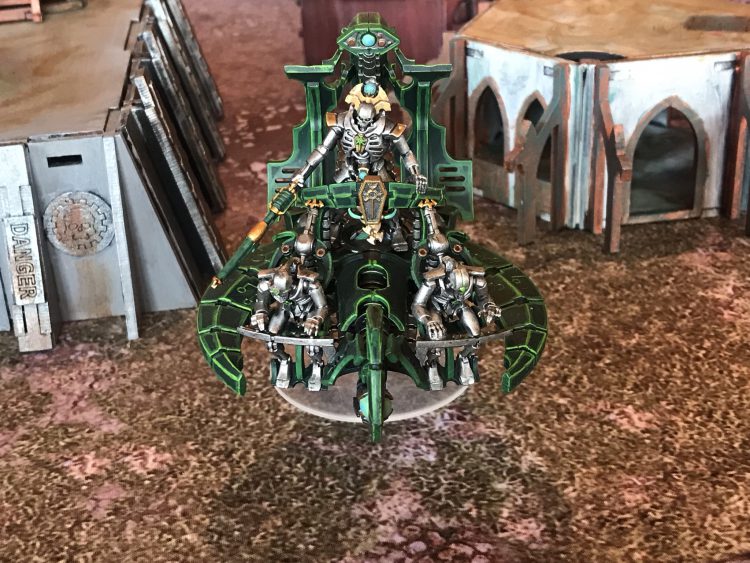
If you can find 50 more points, however, can I recommend the Catacomb Command Barge. Souped up to 9W, so still just below the LoSir limit, Quantum Shielded and able to float around at greater speeds, it does everything an Overlord does (including having the OVERLORD and NOBLE keywords where it matters) but tougher and faster. The magnificent aerial command unit also has a Tesla cannons trapped underneath, so is a good unit to proc Malevolent Arcing.
Moving down the hierarchy, Lords are still kind of embarassingly terrible at everything, being stuck at 3A with no invuln. Their effect has also changed, with The Lord’s Will now handing out hit re-rolls of 1 to a single CORE unit per turn. They get Relentless March as well, and can bring a Resurrection Orb, but at 70pts they’re a tough sell for one of your limited HQ slots.
Returning from Indomitus to proudly read out the Overlord’s many titles (there’s a great piece of fic in the book about this), the Royal Warden is mostly unchanged other than gaining Relentless March, a nice little bit of extra upside. They’re still toting around a relatively scary relic gauss blaster, and can still allow a CORE unit to fall back and shoot once per turn. There is a part of me that, like with the lord, looks at their price tag and says “but I could buy a spicy Cryptek with that”, and I think the buffs being limited to CORE make them an especially hard sell – but again, if you decided to go all in on just so many warriors they could have a place.
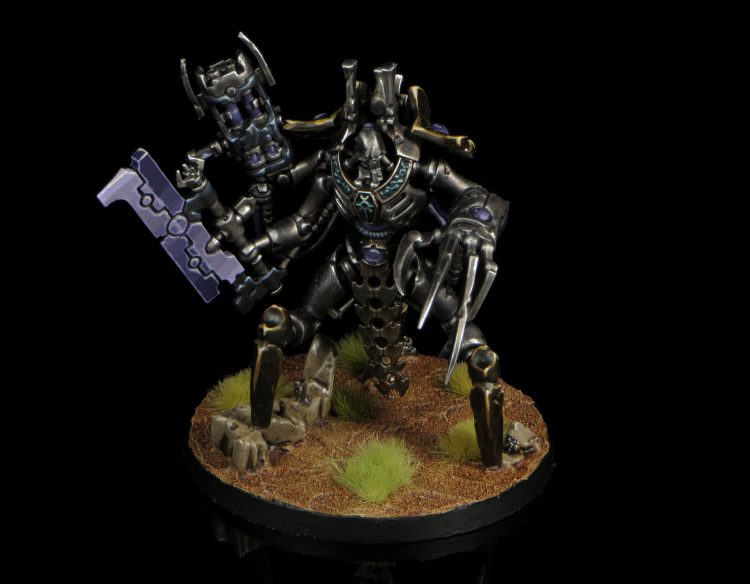
Over in the land of fallen nobility, the Lokhust Lord returns from the old codex and the Skorpekh Lord from Indomitus. Both of these pack the United in Destruction aura, granting nearby DESTROYER CULT units wound re-rolls of 1 – handy as Skorpekh are great and Lokhusts still seem decent. The Skorpeh Lord is pricier and slower, but has a far more flexible offensive loadout in exchange. The Voltaic Staff does give the Lokhust Lord a way around this though meaning that if you need a cheap beater (or want to spend the extra points on a resurrection orb to go with your Destroyers) they’re still worth a look. I’m expecting to use the Skorpekh Lord in most of my early lists, as in character throw downs being able to use Whirling Onslaught is just such a huge trump card, especially when combined with Enduring Will.
From this section, I’d expect most lists not going in on a Named Character to take one Overlord and, if they’re taking Destroyers, one of the two Destroyer Cult characters.
Crypteks
Crypteks have been split into four different datasheets. Crypteks as we knew them in 8th have kind of been split into the Technomancer and Chronomancer, the Plasmancer returns from Indomitus and they’re joined by new “friend” the Psychomancer. All of these have the Dynastic Advisors special rule, allowing you to take two of them in one slot if your detachment contains a NOBLE – handy if you’re trying to squeeze in a few extras without adding another detachment.
We start strong with the Technomancer, and while a lot of these are cool, this guy does a tonne of stuff supporting multiple archetypes. As baseline, in your command phase they can reanimate one model from a CORE unit, or d3 Warriors. There are lots of ways you can make him do more than that though. You can optionally upgrade him with either a Canoptek Cloak or a Canoptek Control node. The former is a steal at 5pts, giving you a 10″ FLY speed and allowing you to repair a Dynasty model for d3 wounds at the end of movement. This is vastly more flexible than it used to be, and can be super helpful for getting a wounded character ready to re-join the fray. It’s also handy for making sure you’re in position to make use of any Arcana you’ve brought along. The Canoptek Control Node is more of a build-around, giving a 6″ aura of +1 to hit for CANOPTEK units. This is an incredibly potent buff, and especially good with the spiicy Canoptek Doomstalker. It’s good with the melee stuff too, but keeping up with them can be more of a challenge, meaning you might want to add Thrall of the Silent King to increase the range.
The Psychomancer is a debuff thrower. In your morale phase, you pick an enemy unit within 12″ and roll against their leadership on 3d6. If you beat it, you get to pick one of four debuffs, including stripping off Objective Secured, making them unable to perform Actions, slowing them down or suppressing Overwatch in your next turn. All of these are quite powerful, and depending on where the metagame ends up around secondaries there could plausibly be a place for this. They also have an aura that subtracts 1 from leadership and combat attrition tests for enemies within 6″ – potentially hugely impactful if you can land it just right, but extremely risky to pull off.
The Chronomancer is the space wizard’s space wizard, all floating cubes and weird time magic. They’re packing another extremely useful buff, allowing you to select one unit within 9″ in your command phase to get charge re-rolls and a 5++. Unlike a lot of things, this isn’t restricted to CORE (just DYNASTY), so can be powerful on a wide range of things such as Skorpekh Destroyers, Tomb Blades and Lokhusts. They also pack two different weapon options which are both pretty cool in their own way, and actually has a built-in invuln unlike the rest of these fragile chumps. They’re also faster than the rest and can FLY. They’re fractionally more expensive in support of all of this, but not enough so that they aren’t easily the second most interesting after the Technomancer.

Finally, the Plasmancer. They’re pretty cheap and throw out damage and mortals (slightly more efficiently with increased range on the mortals and the ability to do so after advancing), That’s kind of it and they’re kind of fine – I do wonder, now that people can have lots of these, if stacking them up might turn out to be OK, especially as Szarekhan to lean on the re-rolls. I worry a bit that Necrons mostly want a mixture of pressure and combo stuff, and their abilities don’t really fit that, but I’m willing to be proven wrong.
In the initial phase at least, dust off your Technomancers (which you definitely have if you played 8th) and smash the buy button on a Chronomancer.
Named Characters
All of the Named Characters from the previous edition return, and there’s quite a few upgrades.
Starting off with the previous biggest cheese of the Necrons, Imotekh gains a lot. He retains his ability to double-tap on MWBD and his main weapon is as good as ever, but his other sources of damage have been boosted. The Gauntlet of Fire is now 12″ range with a heavy flamer profile, letting him rack up some body count against hordes, while his Lord of the Storm ability trades being a bit less good on the initial target (now 3MWs on a 4+) for splashing on a 4+ rather than only a 6. This is going to do way more damage overall on average, and could be especially nasty if you lined him up with some C’tan throwing Transdimensional Thunderbolt and a source of Malevolent Arcing. At the point where everything in a bubble is taking 2-3 mortals, with more to come in later turns, some armies have a real problem. Finally, he now gives 2 extra CP rather then 1 in trade for losing his niche Flayed One buff. I guess they are quite a bit better now, but for most armies you’re happy with the trade.
Orikan the Diviner returns as a Sautekh-specific (edit: nope, Orikan is a Dynastic Agent now) Chronomancer, with his buff being able to target NECRONS units rather than just DYNASTY. That’s potentially very good with Triarch Praetorians, and even has the out-there edge case of throwing charge re-rolls onto a C’tan. Speaking of C’tan, he retains his ability to level up to a C’tan like profile if you roll less than the current round number in your command phase, making him quite dangerous in melee given he also fights first and ignores invulns. WIth only 5 turns in the game this is less likely to come up, but it’s nice when it does. Finally, he has an invuln built in to replace the one he loses by the Chronometron aura no longer being a thing. He’s not cheap, so you do need a proper purpose for him (probably Triarch Praetorians), but you do at least get a good package for the price.
Anrakyr the Traveller is slightly tuned down from where he used to be – he’s still a generic, Dynastic Agent Overlord, but his +1A aura now only affects CORE. There’s almost certainly still a use case for him in Novokh, as you can stack him with their strat to turn a unit of Warriors into an absolute blender, but elsewhere he’s probably a bit weaker, especially given as mixed Dynasty lists (which he used to help enable) are going to be very rare. His ability to seize control of an enemy VEHICLES gun has also changed to a roll against Ld rather than a flat 4+, on 3d6 most of the time and 2d6 against TITANIC. That nets out to being more reliable against small stuff and less reliable against Knights and their ilk, a definite sidegrade. Overall, given he’s still pricy, probably for specific lists only.
Vargard Obyron probably doesn’t see much use – he continues to be essentially a dedicated bodyguard for Nemesor Zandrekh, and loses his ability to bring a unit with him when he teleports to Zandrekh’s side. Zandrekh is quite a bit improved, but with everything being pricy it’s still hard to justify his cost.
Zandrekh himself has a surprisingly good go at achieving that, as both his special abilities have been changed favourably. Transient Madness is now a buff for CORE only, but rather than it always being a random buff you now roll 3d6 against Zandrekh’s Ld, and if you pass you get to choose. Getting to specify the effect slightly under half the time means that in any given situation you have a better than average chance of getting what you want (as you still get a 1/3 if you fail the check). The real spice is the change to Counter Tactics. Rather than turning off Auras (theoretically good, clunky on a slow model in practice), now once per game when an opponent tries to use a stratagem you can just say “no”, it isn’t activated (so no CP are spent) and can’t be used for the rest of the battle round. Expert observers may recognise that as “free, reliable Vect” which is quite the thing. Whether it’s enough to make you want to take him over Imotekh (who is much more deadly in his own right) is an open question, but the fact that I’m even asking that question is an impressive uptick from last edition.
Despite his new statline getting added right at the end of 8th, my boy Illuminor Szeras improves further. First up, his shooting attack has been returned to having 36″ range while keeping d3 shots, allowing him to provide a potent game-long shooting threat. He gains the Technomancer’s Rites of Reanimation ability, but because he’s a cool guy he gets to use it twice. The huge win though is that he’s the first unit I’ve seen to massively gain by one of their abilities being changed to key off CORE. Mechanical Augmentation can now target any Core unit, which puts Tomb Blades, Lychguard and Deathmarks on the table along with Warriors and Immortals. Adding in the fact that Warriors are of renewed relevance, and Szeras seems real good. I’ll have to get around to either painting my new one or sticking my old one on a big ziggurat made of plasticard and the new massive base and calling the job a good’un.
Finally, Trazyn shifts from being Nihilakh to being a Dynastic Agent. He now acts as a generic Overlord and keeps all his existing nonsense, being able to take over the bodies of your other Characters on death, terminally detonate enemy character’s heads in the fight phase, and now even gives you a free relic (plus some extra rules for Crusade). He doesn’t really fit into any plan, but he’s good fun and available to more people who want to try him out now.
Troops
Necrons still have two Troop choices, Warriors and Immortals.
Warriors seem like they get a new lease of life with this book. Bad news first – they have gone back up to 13ppm. Boooooooo. However, the good news is that they benefit hugely from the updated Reanimation Protocols (which they re-roll 1s on), have a tonne of strats to boost their damage output and also see the gauss reaper get better from Indomitus, now being Assault 2 12″ rather than Rapid Fire 1 15″. That’s a massive upgrade for most situations, and any warriors riding in Ghost Arks probably want the reapers. I would also probably try 10 flayers/10 reapers in any list where i was planning on leaning on mobility tricks, such as using Relentlessly Expansionist to push up the table. I’ve got a tonne of these guys waiting in the wings, and I’m ready to get them out again.
Immortals are probably still OK, but a bit pricy. They get some buffs, gaining T5 at base and having their gauss option go up to 30″ range, but the downside is that Tesla is way weaker than it used to be, only triggering on an unmodified 6 and here having a 2PPM price premium. Given that the buff support for Gauss is also just better, I think there’s a use case for trying that option out as well. Equally, the flipside of Tesla being unmodded 6s is that you can advance and still proc it now, which could still be useful. The big concern I have with these, honestly, is that already when I’ve been trying to get blocks of 10 into lists I’ve been struck by being able to have 10 Warriors and some Crytpothralls for Actions at the same price. These do remain the cheapest way to get a troop choice on the table for the faction, so they’re bound to see at least some use despite that, especially if people are trying to get multiple C’tan out.
Elites
Spooky Skeletons
Starting off Elites with the normal-ish Necron units, we have Deathmarks. These gain the same T5 as Immortals (nice) and have their guns re-vamped, now being more conventional sniper weapons at heavy 1 36″, though having a decent S5 and AP-2. That’s enough that 10 of these are a real worry for enemy characters, especially as they’re base BS2+ and can be further buffed thanks to being CORE. Also able to deep strike natively and intercept with Aetheric Interception, they seem like a reasonably plausible tool for holding a home objective while projecting some threat in some lists, though investing enough points into them to make them worth it could be a tough ask.
Lychguard get an extra attack compared to their old profile, and see their shields upgraded to be equivalent to storm shields, adding one to their armour saves as well as giving the 4++. That’s a nice implicit trade-off from no longer being able to buff to 3++. Also being CORE these generally seem pretty reasonable all round, especially if you’re bringing some of the buff characters and I fear the main thing that’s going to hold them back is that Triarch Praetorians got an even bigger glow up, come in the same box and are cheaper. Small units of these feel like they could have play in a Novokh list with Anrakyr though.
Also in melee land, Flayed Ones pick up some boosts, but are weirdly held back by not being CORE. They keep their deep strike, trade wound re-rolls out for extra hits on 6s against non-VEHICLEs and -1AP, and have a flat -2Ld aura. All of this is brought together by being slightly cheaper, and combined with access to powerful strats on the offence and defence there’s got to be a place for these in Novokh, where the +1″ to charges out of deep strike and the stratagem really helps. I think these are probably good now, it just baffles me what the criteria for not being CORE is.
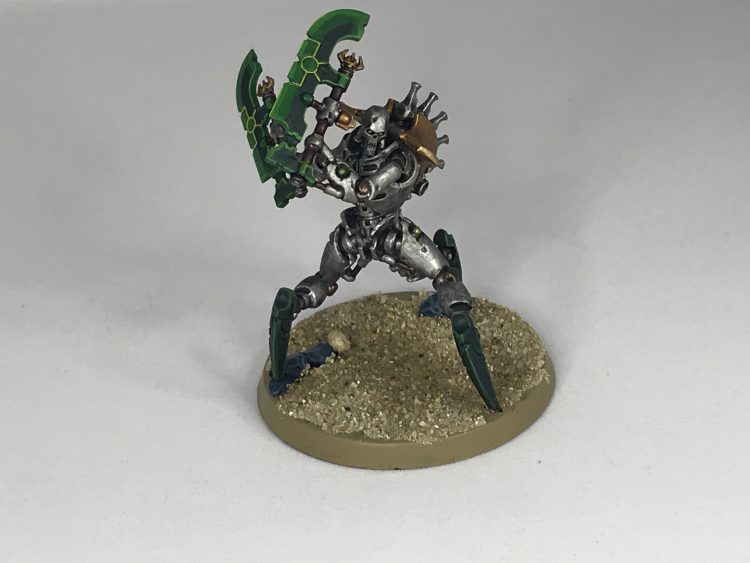
Speaking of melee units – Skorpekh Destroyers. chefkiss sounds ensue. These have the same statline as in Indomitus (i.e. brutal killers), but can now be taken in units of up to six and got cheaper, going down to 35ppm each. Add in the ability to use Whirling Onslaught to protect them and you have a premium unit that’s going to be filling the Bladeguard role in the Necron army extremely well. The only downside is that the Canoptek Plasmacyte is now a separate unit, and to be fair that’s only a downside because it would have done weird cheesy nonsense to the Reanimation Protocols math otherwise. For what it’s worth, the Plasmacyte has a bunch of rules that tightly couple it to whatever Destroyer unit you’ve purchased it for, and the designers have smartly prevented it from being able to perform actions. It still has the same power infusion effect, which is a bit more interesting with high-model count units, but the Skorpekh basically don’t really need it to be fine.
Still in Destroyer land, the Hexmark Destroyer is here. They’re…odd. They have six enmitic pistols and always hits on a 2+ (even on overwatch) and can do quite a number on horde stuff (getting to shoot a pistol again for each model killed on the first volley) – but for the apparent purpose of dropping in and intercepting stuff they end up a bit lacklustre – the guns are only AP-1 D1, so against anything crunchy there’s a limit to how good he’ll be. Equally, there are some matchups where they’re devastating – strategic reserved Repentia are super popular in Sisters, and trying to bring them on against one of these is a huge headache unless invuln buffs get brought over to help out. Being a cheap character you can plonk down to spread Command Protocols is also an inherant upside. At 75pts, I think this’ll see use as it’s priced right for a utility tool, but it’s not quite the instant slam-dunk that, say, the Kelermorph was.

Last in this section is the Triarch Stalker. This is basically just good. The targeting relay, allowing other units to re-roll hits of 1 against whatever it shot doesn’t gain a CORE restriction, so it’s a powerful tool if you’re bringing any big guns on vehicles or constructs. The heavy weapons all get better in 9th’s move/shoot world, the Heat ray (probably the best option) benefits from seeing both the standard flamer and melta changes incorporated, and the whole thing gets gifted an extra 2W to boot. These are a bargain, get one.
Canoptek
Three Canoptek units sit in this slot, and two are very good while one remains puzzling.

Cryptothralls return from Indomitus, and with 3 months more information about how the game plays we know that cheap INFANTRY units that can be chucked into strategic reserves in bulk to pop out to perform Actions are really good. You can still take one of these without using a slot for each Cryptek you have, but it’s also now clearer that you can take them even if you aren’t packing them, and they’re a really good way to spend a last 40pts.
The other unit here is another big one – having been the army’s laughing stock for all of 8th Canoptek Spyders are back and they are pissed. At only 60pts per model in units of up to three and coming with a pretty ferocious statline, they’re a very effecting push threat that’s extremely well placed to benefit from a whole host of powerful buffs. Also, they’re the biggest thing you can blip back into life with the Phylacterine Hive, a sure-fire way to crush your opponent’s dreams. Getting a unit of these ready to go was the surprise painting task I didn’t know I was going to have, but I’m here for it. Oh, they still randomly reanimate Scarabs for free, so have fun with that.

Finally, the Canoptek Reanimator. I do not “get” the Canoptek Reanimator. The Reanimation Beam is clearly very good to have on a big unit that is under fire, but with the effect being so short ranged and requiring visiblity, it’s frequently going to be impossible to set it up without this being visible, and it’s so squishy for the cost that it’s a tough sell. The Reanimation Prioritisation strat makes this just that bit closer to worthwhile as alpha strike prevention, as you can hide it behind terrain (but still able to see the unit you want to protect at an angle or something) and turn the beam on when your more precious stuff is shot. You could also theoretically bring this on from strategic reserves to do the same later in the game. With that option open I guess you can maybe make this work (and it’s obviously considerably better against pure melee matchups) but the use remains so clunky that I’m yet to be convinced this is something I want in my armies.
C’tan
Let me tell you want I do want in my armies – C’tan.
This shouldn’t actually surprise anyone familiar with my past exploits, as I am a notorius C’tan stan, but holy moly have there been some changes here.
Fundamentally, C’tan have been changed from the OK mid-tier bruisers they were in 8th into proper, terrifying monsters again, with the Nightbringer standing out as a contender in the stakes for scariest single unit in the game right now.
Let’s start with the basics – there are four C’tan options in this slot, the three named ones (existing plus Void Dragon) and the Transcendant. The increased power definitely comes at a price (350 for named, 270 for generic) but what you get for that is quite something.
The defences are the eye-catching thing out the gate. They have T7 and 9W each, which isn’t massive, but all have the Necrodermis rule, giving them a 4++ and meaning they cannot take more than three wounds in a phase. Just like with Ghaz and Exalted Bloodthirsters this means there is only ever so fast an opponent can pop one. What’s more, they all have Living Metal, meaning that if they last through to your turn they get a wound back. For armies relying on shooting to clear them out, that makes killing these viciously impractical, and you need some sort of multi-phase plan. The only silver lining for enemies planning to go after them at range is that none of them can benefit from Look Out Sir. If you’re up against these, you need to try and pack damage into them whenever possible.
All C’tan also know two powers – the named ones all have a unique one and one from the list, while the Transcendant picks two from the list. Rather spicily, all the named ones also get two uses each, with the only downside being that they can’t use them if they Advance or Fall Back. The former is probably more of a problem than the latter for how you’re going to use these, just saying.
Each C’tan also has their own tricks, starting with the Deceiver. They can deep strike (very nice with the wound rate limit), has built-in -1 to hit (sure), and in his most eye-catching ability can enact a Grand Illusion at the start of the first battle round. This lists you redeploy up to three units within your deployment zone or move them into strategic reserves. It’s not quite clear if you have to pay the CP for the latter, but either way this is absolutely fantastic, letting you adapt to the crucial roll-off as needed. The Deceiver’s special power is essentially mind war (without being limited to CHARACTERS) – pick a target, roll off and add leadership, and if you win deal mortals equal to the difference. Quite swingy, but with Ld 10 the odds are often in your favour, and here the spikes where you do truly appaling damage probably pay for the times you miss. The only tradeoff for the Deceiver is that they’re the least capable in a fight, “only” having five damage three attacks. That does make him vulnerable to getting tarpitted, so make sure you’ve brought some volume damage as well.
The Void Dragon was largely previewed over on Warhammer Community. Throwing the spear in a line is hilarious, and it will tear stuff up in melee too. Something they didn’t mention on WarCom that actually makes a big difference is that they also gets d6 attacks with their tail blades, helping to deal with hordes. The custom power is an anti-vehicle tool, dealing d3 MWs to a unit at range (d6 if it’s a vehicle) on a 2+, and halving the target’s remaining wounds for determining stats if it has a degrading profile. Vehicles aren’t a huge part of the meta right now and you do want them around to get the most from this guy, but they’re no slouch otherwise and I’m certainly still going to pick him up as the world’s number one C’tan appreaciator.
Lastly though. The Nightbringer. Oh the Nightbringer.
Good. Lord.
In terms of killing power, the Nightbringer is in a league apart from, well, damn near anyone. The custom power (a replacement for the old Gaze shooting attack) is vicious right out the gate – you pick a target (with no LoSir-like restrictions or anything) and roll 3d6, doing d3 MWs for each 4+. Straight up just murdering 4W characters half the time. NBD.
It’s the statline that’s the real gold though. The Nightbringer gets an extra base attack and point of S compared to all the others and has a sweep attack, allowing him to throw out 12 S7 AP-3 D1 attacks when needed. However, if you need something, anything really dead, use the big swing. This hits at S14, AP-4 for d6 damage, ignores invulns and, in the final kicker, bypasses any abilities that prevent damage. No feel no pains allowed. Ghazghkull’s ability? Doesn’t work. Other C’tan? Dead.
So yeah. Want a unit that can one-round Mortarion, Magnus, Ghazghkull, probably even Big Bird (though abilities that reduce attack damage characteristics do still work, so maybe not quite that last one)? Then invest in your Nightbringer today. Words cannot express how gleeful I am about this.
After that, Transcendant C’tan are kind of a climbdown. They still get to either pick one special ability or roll for two, and they do now get to re-roll if they get a duplicate, but there are still enough trap choices that you want Cosmic Tyrant to double cast powers almost every time, especially with them being boosted. Being quite a bit cheaper than the named ones does give these some appeal, and I can imagine trying them in lists still – but then I would say that.
Fast Attack
The hits continue with plenty of power in this slot.
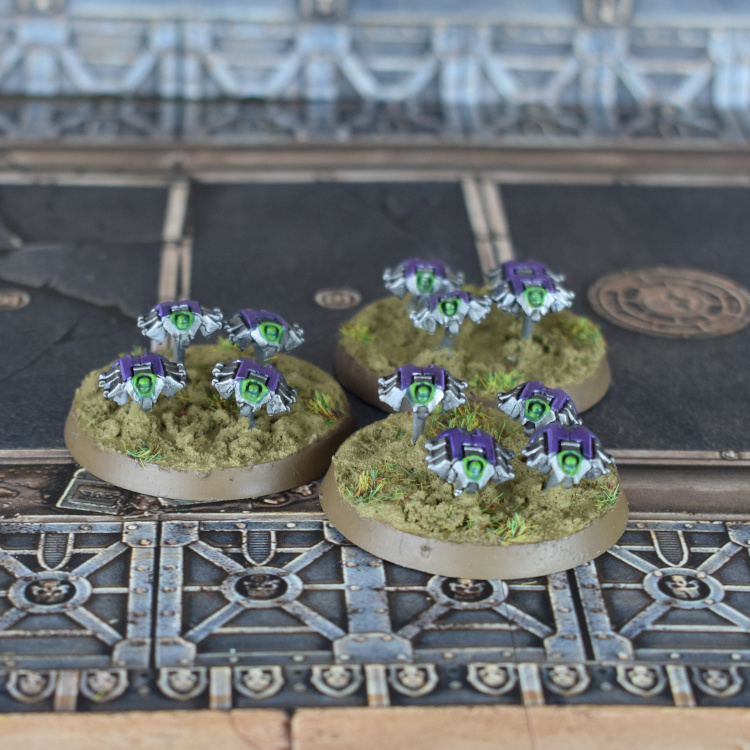
Let’s get the easy ones out the way first. Scarabs are still fine as space fillers (and you can take them in 9s again), and thanks to all the boosts to Canoptek and melee can actually do some legitimate damage in some situations. Swarms in general are performing in 9th and these are no different.
Also probably in the “still good” bucket, Tomb Blades. Slight price drop, gain the CORE keyword and don’t pay a premium for their Tesla, unlike Immortals. Even the Particle Beamer option has had a surprise massive boost, doubling in shots at the cost of 6″ of range. Since that’s 5pts cheaper than the other options it’s worth a serious look now, and this unit ends up sufficiently all-round good that almost every build is probably worth it somewhere (even gauss given how much the book pushes rapid fire).
Triarch Praetorians are also gigantic winners here, riding on the back of going up to three attacks base and getting D2 on both modes of the rod of covenant. That means you should be taking the rod 100% of the time, and what you end up with is a durable, fast unit that can do work in multiple phases. They’re even better alongside The Silent King, who can use a lot of his effects otherwise locked to CORE on them.
Another surprise improvement is Wraiths. Up front things don’t look great, as they lose their 3++ (which, again, seems to just be Not A Thing any more, and frankly good). However, they retain a 4++, gain a 3+ base save and drop a massive 10pts each. While there are a few other stat changes, at 35PPM these are just good in 9th – fast melee units that are still pretty tough are exactly what you want in your armies, and a whole bunch of stuff here boosts melee and CANOPTEK units. In some situations they also end up tougher than before – as BEASTs they can benefit from Light Cover, so if you can get them into terrain then against volume AP0 fire (a common way to put them down) they’re now at a 2+. Pleasantly surprised by how well these came out, and looking forward to getting mine back on the table – maybe even aiming to double up to 2×5.
What’s good for Wraiths, sadly, ends up bad for our last entry, the Ophydian Destroyers. These have a whole bunch of abilities, and generally net out at being a bit more deadly than the Wraiths on offence, but the tradeoff is that they are appallingly squishier on defence, being T4 4+ with no invuln. At the same price point, that makes these feel really hard to justify, and while they’re not a bad unit by any stretch, I’m skeptical they’ll make the cut that often over the more durable options of Skorpekh and Wraiths.
Heavy Support
Mostly returning friends here. The Annihilation Barge remains as forgettable as ever. It has actually picked up a few minor boosts, and is maybe fine in volume in Mephrit, but it continues to mostly be an answer to a question no-one asked.
The Doomsday Ark gets switched over to the new quantum rules and gets a 10pt increase, and I’m not hugely sure how to feel about it at this point. If you just want the spicy big gun you now have the option of the Canoptek Doomstalker instead, so if you’re aiming to get value out of this you need to be moving and using the gauss. However, once you start moving then you don’t get to shoot the big gun as effectively, and it’s all a bit confusing. My gut feel is that these have ended up slightly pricier than they should have done – maybe a relief for people sick of seeing three, but a relief for everyone else.
Lokhust Destroyers (rebranded from vanilla destroyers) lose 2″ of movement for some reason, but are still one of the better sources of flexible killing power in Necron lists. While the nerf to Extermination Protocols stings, the fact that it still gives you full wound re-rolls means that the high-rate firepower from the gauss cannons can adapt to almost any target. The advent os strategic reserves opening up the option to deep strike them in any dynasty is obviously great, and you can now add a Lokhust Heavy in addition to 6 regulars instead of replacing one (though I expect 4+1 to be the default setup for Blast reasons). Adding a Heavy is a very good defence against flat damage three weapons, and embedding a single gauss destructor shot in the squad is nice
Moving on to the Lokhust Heavy Destroyers, I’m still not quite sure what to think about them. 70pts each is a lot – they aren’t really tough enough to justify that price tag, and their weapons are also very polarised in what they’re good at. Running three singles with the big gun in Szerakhan is extremely funny, but having thought about it I suspect the main other place you might see multiples of these is in Mephrit. Being able to add a point of AP to the enmitic exterminator in addition to wound re-rolls makes it a great all-purpose gun, and there I think a squad of three of these could do work. Beyond those two scenarios, I see embedding singles of these in Lokhust squads as the main use case.
Finally, we have our genuinely new entry in this section, the Canoptek Doomstalker. This guy is super pushed, and I think the premium anti-tank ranged option available to the faction once you buddy them up with a Canoptek Control Node Technomancer. At only 140pts each, you can get three of these down at a scarily low total, and their combined firepower is horrific, not even being terrible against hordes thanks to Blast. Adding to that, wandering around in a group of three is great for them, as they essentially get For the Greater Good, so anything charging any one of them risks catching a doomsday blast to the face. Finally, Revenge of the Doomstalker is an ever present threat your opponent has to real with while these are about. Great unit, probably good enough to see play in 3s even in this melee-focused metagame.
Flyer
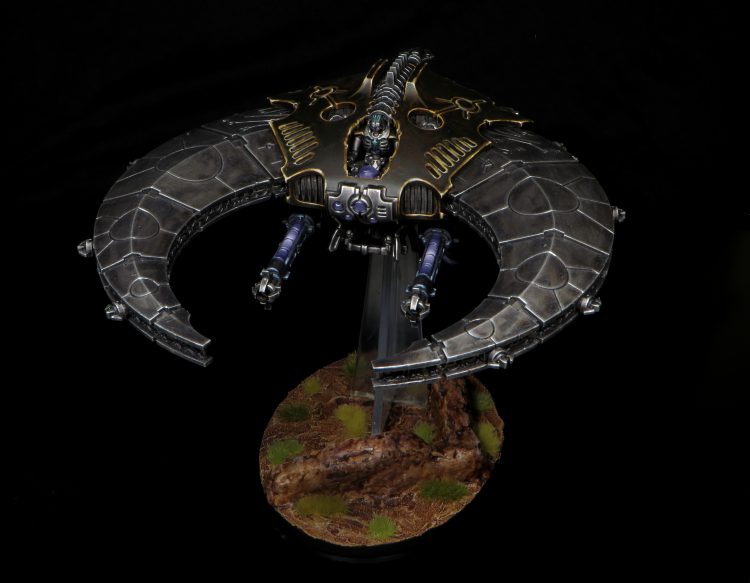
The Doom Scythe, once the terror of all the foes of the Necrons, probably ends up on the bench for now. It isn’t bad as such, with its main gun having been turbo charged to hilarious heights and having a good anti-horde secondary weapon, but my overwhelming experience of the edition thus far has been that spending 200pts on a plane is a very tough sell, especially one without an invuln to protect it. I could be wrong here, as the flexible offense is decent, but I don’t expect these to feature in top lists in anywhere near their previous numbers.
The Night Scythe, on the other hand, is suddenly way more interesting because they finally fixed it – it’s straight up just a Transport (for CORE, DYNASTIC AGENT and CHARACTER INFANTRY) now, and one with a mighty 20 capacity to boot, priced to move. Quite genuinely, I don’t know exactly how to feel about this. On the one hand, the strength of transports in 9th is that you move them onto an objective to put it under your control, then if your opponent kills the transport whatever is inside keeps holding it, and as an AIRCRAFT this cannot do that. On the other hand, being able to potentially deploy 20 models to the mid-board in moderate safety (especially with the uptick in the number of lists that can barely interact with planes) is a crazy capability to have access to, not to mention doing stupid things like a Skorpekh Lord clown-car. I think this will see experimentation – it may turn out not to quite work, but this is such an out-there capability that it needs to be properly looked at.
Lord of War
They made the Monolith a Lord of War GW noooooooo.
Ugh, so. All Lords of War that are not Knights or Supreme Commanders are really tough to get into lists, coming with big CP price tags and not benefittting from detachment abilities in Super Heavy Auxiliary detachments. That means that anything in this slot needs heavy scrutiny, and despite an incredible upgrade in many ways, I don’t think the Monolith quite survives that. Losing FLY is also a huge problem on the relatively dense boards of 9th.
The better news for it (Obelisk and Vault too) is that it gets a base 2+ save, which goes a decent way to making its lack of an invuln less of a problem. It’s new mode of operation (bringing in CORE units from strategic reserves) is cool as well, as is being able to swap the gauss for death rays (though you do pay a cost, and honestly I’d keep the gauss a lot of the time). The main gun is also heavily boosted, gaining strength, Blast and damage. Finally, the fact that in melee it auto-hits with 6 attacks at S8 AP-3 D3 is totally hilarious. It’s all nice – but I don’t think it’s nice enough to justify its cost and price tag. Hilariously, I think if there is a list that uses these there’s a good chance that it’s three of them – stick the pre-game move and ObSec on a full super-heavy detachment of them, zoom them up the board and start ramming and eating anything sitting on objectives. I’m only partially joking here – you still have 900pts to play with afterwards, and being mown down by three furious, hungry, ObSec boxes (with huge amounts of anti-infantry shooting attached) is something some armies are actually just dead to. Everyone loved the last time Necrons had a list with three big boxes right?
On that note, the Tesseract Vault. This gets numerous improvements, and I’m more ready to look at actually taking this in a Super Heavy Aux (especially as it can’t benefit from detachment abilities anyway). The general boosts to C’tan powers obviously help it, it gets a point cut and two random extra wounds, and a 2+ base save is fantastic. The only major issue is that it’s now measure to hull, creating a whole bunch of rules nightmares and forcing me to go measure whether it actually fits in every GT pack deployment zone before I deign to finish painting mine.
The Obelisk is the last returning hero, bearing the dubious title of being voted the worst unit in the entire of 8th Edition by the competitive community. It still isn’t good, but enough has been done to make sure it’s no longer upsettingly terrible. When it stays still its guns now get a tonne better, making them actually pretty potent (though lacking in AP), and the gravity pulse is now a targeted effect that slows down fliers and can put mortals on planes. Don’t trouble your tournament lists with one, but if you have one built and love it dearly, it’ll be a lot more fun to use now.
Last, but extravagantly not least, the Silent King. Weighing in as one of the longest and most complex datasheets in the game, it’s hard to get a definite read on him by my impression is that he’s incredible. There really is just too much here to go into everything he can do, but the tldr is:
- He starts with two Menhirs that have to take wounds first. Each of these has a prepostorous flat damage 6 doom beam on them as long as they’re up.
- Szarekh himself has a degrading profile, and as well as changing stats, as he loses wounds he loses some abilities that represent the auras and weapons of the two other members of the Triarch with him.
- Szarekh can hit decently hard both at range and in melee with a bunch of D2 attacks, while one of the Triarch is dedicated to anti-horde shooting and the other piles on a bunch of nasty flat damage three melee attacks.
- He’s got all the buffs and auras you’d expect of a Phaeron, but all of these effect NECRON CORE and TRIARCH PRAETORIANS.
- He has shooting hit re-roll and melee wound re-roll auras for CORE and TRIARCH PRAETORIANS, which switch off as he loses Triarch members.
- He gives a few other tasty bonuses like forcing enemies to fight last, granting extra CP and having a deny.
Realistically, I kind of feel like this unit has to be good, because he’s priced well for his defences (26 total wounds with a 4++) and can dish out pain to anything. Early on his annihilation beams make a mockery of many vehicles, while mid-game he throws out a good volume of shots. He’s also both dangerous and a pain to deal with in melee, as forcing enemies to fight last means that glass cannon units like Repentia, who absolutely will not stand up to his attacks, can’t really engage with him. He comes bearing an absurd panoply of buffs, gets one of the best warlord traits in the book, and slots into a Supreme Command detachment as the first newly added SUPREME COMMANDER. Pretty sure I’mma buy him.
Fortifications
Joining the list of units I’m not quite sure what the purpose of is, we have the Convergence of Dominion. These are basically three-part buff relays that deploy in your own zone, but can be slowly teleported to other parts of the board by a Cryptek. They also have a very swingy ranged attack. It’s a neat idea, and definitely better than some fortifications we’ve seen, but doesn’t quite feel like it justifies the cost. That’s especially true because the teleporting is delayed till your next turn, so your opponent has plenty of time to screen it out. Putting 6pts worth of Bring It Down in your list without much purpose is also a touch sell. Cute concept, amazing models that will make awesome terrain, but probably not a big competitive hitter.#
Army Lists
What’s a review without a couple of lists? To close this off and show how we plan to use the new toys, I’ve put together two lists for you. One is deliberately designed to be something I can play straight away with the models I have, while one leans heavily into the new range and upgrades.
Nephrekh Silver Tide
Nephrekh Battalion
HQ
Catacomb Command Barge w/Tesla, staff of light, Warlord, Voltaic Staff, Skin of Liquid Gold – 145
Skorpekh Lord, Extra Trait, Extra Relic, Enduring Will, Veil of Darkness – 130
Technomancer, Cloak, Phylacterine Hive – 100
Troops
20 Warriors, flayers – 260
10 Warriors, reapers – 130
10 Warriors, flayers – 130
Elites
Nightbringer, Antimatter Meteor – 350
Skorpekh Destroyers – 105
Cryptothralls – 40
Fast Attack
5 Wraiths – 175
Heavy Support
4 Lokhust Destroyers, 1 Lokhust Heavy Destroyer with gauss destructor – 290
Dedicated Transport
Ghost Ark – 145
Total – 2000pts, 10CP
This list aims to lean in to the renewed durability of the humble Necron Warrior and the various spicy melee options (most notably my boi the Nightbringer) to put opponents under tremendous pressure. With the Nephrekh translocation, the bulk of these forces can push for the centre very quickly, putting the opponent up against it straight away and forcing them to commit into scything range. Then, the melee stuff tidies up. The list gives up no kill secondaries for maximum points, has the Lokhust unit to clear out a ranged threat (deep striking if necessary), and feels a whole lot stronger than anything like it did before.
I Just Can’t Wait to Be King
Szarekhan Supreme Command +5CP
The Silent King, Warlord – 450
Szarekhan Patrol -2CP
HQ
Techomancer, Canoptek Control Node, Voltaic Staff, Metallodermic Tesla Weave – 110
Troops
10 Warriors, reaper – 130
Elites
Triarch Stalker, Heat Ray – 140
10 Triarch Praetorians, rods – 250
Heavy Support
Canoptek Doomstalker – 140
Canoptek Doomstalker – 140
Dedicated Transport
Ghost Ark – 145
Szarekhan Patrol -2CP
HQ
Chronomancer, Entropic Lance – 80
Troops
10 Warriors, reaper – 130
Heavy Support
Canoptek Doomstalker – 140
Dedicated Transport
Ghost Ark – 145
Total – 2000pts, 13CP
This list is not complicated. You have three Doomstalkers and their Technomancer buddy move into postition at the back and start blasting, while Szarekh and the rest of the army roll up the board to crush all those that oppose them. Adding two Arks and two reaper squads massively shores up horde matchups, as the volume threat is considerable, and the big Triarch Praetorian squad is an especially huge threat in a list where opponents are going to have to choose between trying to kill them and trying to take out Szarekh, especially with the Chronomancer following them around and providing a 5++. They’re strong enough independent operators that the game also isn’t over if Szarekh goes down, as the threat with a list like this is that losing your big toy proves terminal. Szarekh opens up a huge bunch of options, and my suspicion is that he’s actually best in a non-Szarekhan list, but this one shows off ways you can build to that while staying within his Dynasty.
Wrap Up
And that, as they say, is it. What a mammoth review, and what a fantastic change to an army that has long languished in the doldrums. I could not be more thrilled about this book and can’t wait to get my spooky silver horde on the table, and I hope if you’re a Necron player you’re now feeling the same way. Any questions hit us up at contact@goonhammer.com, otherwise we’ll see you next week for more exciting content.
